






■ The Brandeis Food Pantry, formerly known as the FRESH food pantry, has moved to the SCC — but what difference has it made?
By ZOE ZACHARY JUSTICE EDITORIAL ASSISTANTThe Brandeis Food Pantry, formerly known as the FRESH Food Pantry, was founded in June 2018. Though its doors are open to any member of the Brandeis community facing food insecurity, the pantry was originally oriented toward graduate students. Since its founding, the BFP has moved from the Office of Graduate Affairs, to the Usdan Game Room and finally, to room 316 in the Shapiro Campus Center. Additionally, the BFP partnered with Healthy Waltham, a local food pantry from which it receives donations, shortly after its founding.
In a March 13 interview with The Justice, Vice President of Student Affairs Andrea Dine commented on some of the reasons for the switch. According to Dine, the Fall 2023 construction of Usdan Student Center both prompted the move from the Usdan Game Room and allowed the BFP to find a more suitable location. Dine specified some of the assets of the new pantry location, commenting “[The BFP] was literally in the game room. So it was super public, super open. And so it was very visible who was coming in, taking things or not because it’s a glass wall there.” Dine hopes that the new location in the SCC will be at once more “private and accessible.” Dine also noted that for the first time in its history, the BFP has a refrigerator, though they are not yet distributing perishable items.
The Vice President of Student Affairs added that moving the BPF to the SCC did not change the number of students receiving food. According to her, the number of students picking up food in the BPF usually fluctuates from 40 to 60, resting somewhere around the fifties. In fact, around half of the students who are currently registered for food from the BPF do not pick it up. “We’re getting food for
44 students at the moment and 24 actually picked it up,” she noted.
Dine expressed her concern for the graduate student population in particular. According to a recent study, 17% of graduate students and 13% of postdoctoral trainees experience food insecurity compared to a national average of 12% of U.S. citizens. Food insecurity, as Dine puts it, is a “complex web of financial need.” It is just a piece in a balance between housing needs, transportation needs, familial needs and more. In the future, she hopes to create more holistic financial resources for graduate students and take more of these elements into consideration.
Olivia Leland ’24, a fourth year graduate student, also discussed the greater issue of financial insecurity for graduate students. Though she does not currently use the BFP, Leland explained that she used various food pantries through her undergraduate experience and is connected to current users of the BFP. Leland explained during a March 15 interview with The Justice, “A lot of [graduate] students do not make a lot of money,” also mentioning that from what she has seen, humanities students tend to use the BFP more often than STEM students due to having generally lower stipends.
For Leland, however, a different change was much more impactful in the BFP’s functioning: the switch to its current system of food distribution. Since October 2023, the BFP has required that recipients register via an online form to receive pre-assembled bags of non-perishables. An email that Leland received from the Office of Graduate Affairs on Oct. 11, 2023 attributes the need for this system to the “overwhelming presence at the pantry open house” — a puzzling statement considering that, according to Dine, participation in the pantry has remained somewhat stable. While Dine commented that the form to receive food is designed to be as simple and accessible as possible, Leland articulated simply “that was a switch that was harmful to grad students, ultimately because there’s rationing. [You] can’t just go get food.”
Leland also mentioned the role of food insecurity in the graduate student unionization process. Though the graduate student body was already in the process of unionizing when the BFP’s food distribution system changed, Leland explained “that system came out right before our election and I think for a lot of people it solidified ‘yeah, we need to do this’ … We’ve already had so many issues with food insecurity and that was the icing on the cake.” Additionally, according to her, a lot of graduate students are probably seeking healthier, more “cookable” options from the pantry. Like Dine, she hopes that the pantry might be able to use its new fridge to distribute produce in the future.
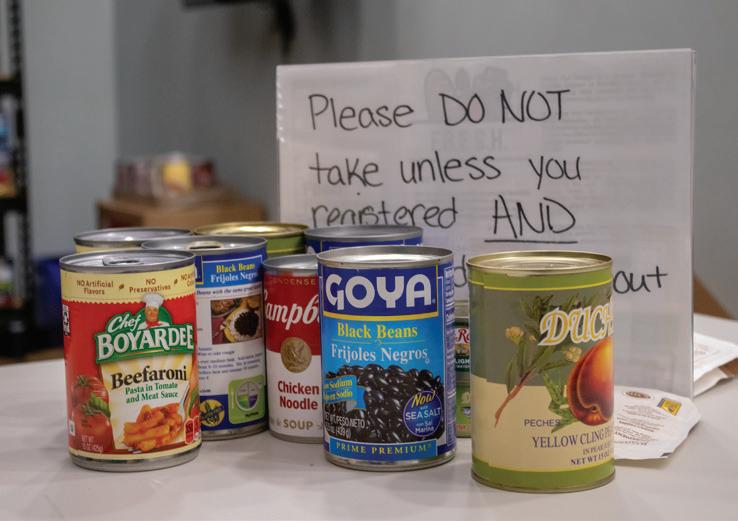

SKYE ENTWOOD/The Justice
RESOURCE : The pantry helps any member of the Brandeis community facing food insecurity.
■ Massachussetts navigates temporary solutions to housing influx of migrants.
Prof. Smith has been committed to the cause for several years now.
Massachusetts has reportedly reached its maximum capacity of migrant influx. However, the issue may not be the volume of people arriving — instead, it may be the local housing crisis.
Earlier this year, migrants from South America, Haiti and other regions of the world were left to sleep on the floor of Boston’s Logan International Airport as the state found migration centers and shelters to place them. As migrants continue to arrive each day, most shelters in the state are at full capacity.
The resettlement process for immigrant families is lengthy. Prof. Douglas Smith (LGLS) is working to provide migrant families with the opportunity to receive asylum.
The Right to Immigration Institute is an organization that was founded in 2016 by Smith alongside a few Brandeis undergraduates. The institute provides migrants with legal representation during the process of seeking asylum in the state. Services provided include legal representation in immigration courts, necessary assistance in finding housing, schooling and protecting them against public harassment on the basis of immigrant status.
In a March 15 interview with The Justice, Smith explained, “At the institute, we train college students as well as migrants and refugees to become accredited department of justice representatives that can do anything I can do as a lawyer in the immigration system.” He said, “We are the only place in the United States that does this, we were the first place to do this and we still remain the only place that does this.”
Smith suggested that Massachusetts’ problem may not be the volume of migrants, but rather the fact that there is nowhere to house them long enough to get them on their feet. These shelters are meant to be temporary, but it takes at least six months for most migrants to get work authorization — thus making them an ineffective solution to a larger issue.
Most recently, the Melnea A. Cass Recreational Complex in Roxbury has been converted into an emergency shelter for migrant families while Massachusetts government officials figure out a better, long term solution for the migration influx.
According to Alex Ruotolo, the community engagement director at the Refugee and Immigrant Center of Boston, not all migrants arrive in the U.S. with the same status. In a March 12 interview with The Justice, Ruotolo explained, “Many of the immigrants who have just arrived are from Haiti. Most of them are here on what is called a parolee status that grants them the right to work and the
On March 14, Brandeis students, faculty and staff received a joint email from University President Ronald Liebowitz, Provost Carol Fierke and Executive Vice President for Finance and Administration Stewart Uretsky on the University’s response to its “short and longterm financial shortfall.”
The email began by acknowledging the state of academia and the “profound transformation” it is undergoing due to various factors such as changing demographics, the rise of online education options and a decline in public opinion about higher education. These factors have contributed to enrollment decline for institutions in Boston and around the country, including master’s degree programs at Brandeis. The joint email described Brandeis’ “forward-looking decisions to address current and anticipated budget deficits, brought on by declines in enrollment in our master’s degree programs, and rapidly-growing expenses due to inflation and other changes in the economy.”
The University has asked deans and vice presidents to develop strategies for their respective departments, with the goals to advance the University’s long-term academic reputation, financial stability and student experience. Additionally, the University’s efforts to reduce costs at the institutional level will include postponing the annual staff performance reviews, as well as any consideration of merit and faculty merit increases until October 1, 2024. According to the March 14 email, faculty members have been asked by the University to continue to complete Faculty Activity Reports, and any merit increases for unionized employees will be determined in accordance with collective bargaining agreements.
The email outlined additional steps the University is taking to address its financial challenges, beginning with seeking a temporary increase in spending rate from its endowment. The Board of Trustees would need to approve the request. Additionally, candidates for faculty and staff positions, not well funded through grants and contracts, will be considered with “even greater rigor.”
Construction of the Science Center expansion process, called Science 2A, was expected to begin in late 2023 and cost about $145 million. The approximately 100,000 square feet expansion of new and renovated space would have included the addition of an engineering science program at Brandeis. However, there will be a pause to the process, according to the email. In response to on-campus housing challenges in recent years and in an effort to enhance “the student experience,” constructing new residence halls will be prioritized, as the University is aware that it “is vital to student life … as competition for students grows more intense.”
The signatories of the email concluded that they remain “optimistic that these actions will help to reduce the University’s overall deficit and serve as an effective first step to help manage additional cuts that will need to be made in order to balance the budget.” They acknowledge that the steps addressed in the email “won’t be easy” but are confident the financial decisions will allow for the University to pursue its academic mission.
right to federal benefits.”
Unfortunately, the same is not true for others seeking asylum.“It’s a problem of the government’s own making because they won’t let people work,” Smith said. “It’s a long process that isn’t open to everyone — it isn’t a line you get in like people talk about. You have to fit into very narrow categories. Unless you can make a claim for asylum, have a relative in the U.S. or … win the diversity lottery for a visa, you can’t apply for a work permit.”
Massachusetts is the only Right-to-Shelter state, meaning that they — by law — have to provide housing for migrant families in desperate need. The Massachusetts law is unique because it guarantees housing for entire families, but does not protect homeless individuals.
When families arrive in the state they’re given housing at places like hotels and recreational centers until they are able to handle these things on their own. However, due to issues like lack of space for them and a slow process to begin work, these shelters end up housing migrants for much longer than they initially intended to.
According to Smith, the problem with finding migrants housing is that there is not a specific number of migrants that the state accepts, and there isn’t anywhere to house them. “It’s an existing problem here [in Massachusetts] that there is not enough housing and it’s becoming increasingly more expensive,” said Smith. “The real commitment would be to let people work. They would fill jobs and could afford their own houses. If they are able to do that, they wouldn’t be in shelters.”
As shelters continue to fill up, Smith’s institute remains dedicated to resettling migrant families as soon as possible.
— Editor’s Note: Justice Arts & Culture Editor Nemma Kalra ’26 is associated with The Right to Immigration Institute and was not consulted, did not contribute to, nor edit any parts of this article.
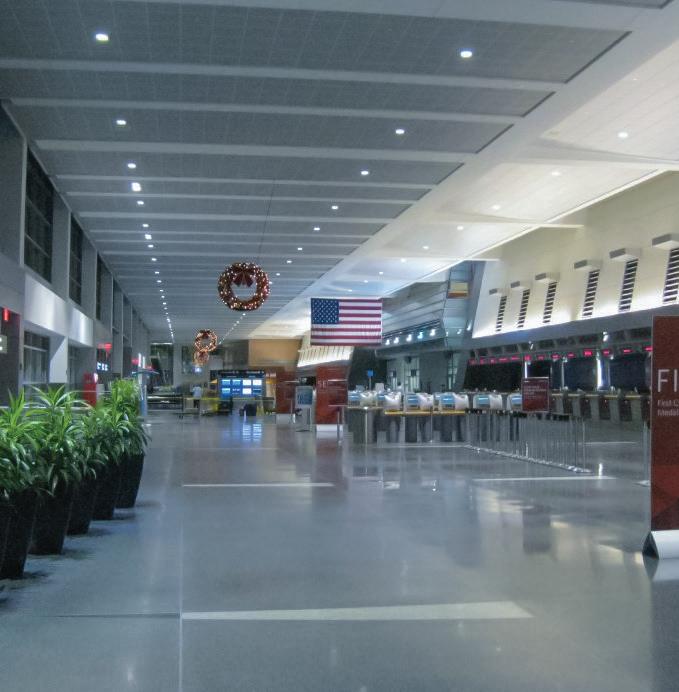
The first issue of The Justice was published in March of 1949, only one semester after the University was founded. For the past seven decades, generations of student journalists have covered key and groundbreaking stories, ranging from the Ford Hall protests to national elections. Without the work of these students, there would be little to no record of the big and small parts of Brandeis history — both the good and the bad — that make this University what it is. This week’s front page is modeled after the first edition, old logo and all. The intention of the anniversary edition is to commemorate the past 75 years of reporting, editing and dedication, without which our editors and staff wouldn’t be publishing at all. Thank you to Justices past — I hope we’ve made you proud.
— Isabel Roseth, Editor In ChiefThe Student Union meeting on March 17 consisted of multiple club presentations. Five clubs presented their case as why they should be chartered or moved to probationary status and the Student Union voted on whether or not to accredit them. Four out of the five clubs passed the presentations. The fifth club, Business for Dummies, was not accredited by the Senate due to its resemblance to other clubs already established on the Brandeis campus.
The first club to present was The Hidden Opponent, where the Student Union heard from the club’s two presidents, Dominique Paglia ’25 and Lexi Kaufman ’24, as well as their vice president, Gabe Levin ’27. THO is a national organization, and these students want to open a chapter at Brandeis. THO raises awareness for mental health in sports culture and provides a safe space for student-athletes to discuss topics surrounding mental health in sports.
Since THO is a national organization, it has many resources, which it plans to use to educate on mental health, implement changes at the Gosman Sports and Convocation Centerrelating to all student-athletes and create a more positive environment.
The club has two advisors: Julia Horvitz, a community therapist at the University, and Kaitlin Carson, a strength and conditioning coach. Over the past several months, the club
MEDICAL EMERGENCY
has organized awareness games, month-long discussions and other activities. They plan to organize more events in the future.
After a brief time for questions, during which it was found that a student does not have to be an athlete to join and that over 40 students had expressed interest, the Student Union voted to charter the club.
The next club to present was the Brandeis Animajors Club for All, which was presented by its prospective president, James Lew ’27. He was motivated to create the club due to Brandeis’s lack of a centralized anime community. The BACA club has hosted two viewing events so far and plans to continue doing so. The club also wants to partner with other cultural clubs to organize events.
BACA aims to create a lasting anime community for everyone, especially those who have never seen anime before. The Student Union voted to make BACA a probationary club.
The Students of the Caribbean Association was presented by their president, Abygail Francis ’26, and the vice president, Shaniece Nugent ’26. SOCA is an aspiring cultural club that promotes Caribbean culture and facilitates a space for history, diversity and education.
SOCA has held a couple of events in the
Mar. 12—A party had a cut on their head from a sports match and was feeling dizzy. The patient refused medical treatment.
Mar. 13—A reporting party requested Armstrong Ambulance for a party who fell on a playground and suffered a large bump on their head. The patient was transported to a local hospital via ambulance.
Mar. 13—There was a medical emergency for a party experiencing shortness of breath and a fast heartbeat. The patient was transported to a local hospital for further care.
Mar. 14—A reporting party requested BEMCo for a party who fell and hit their head. The patient refused medical treatment.
Mar. 8—A party reported an individual taking photos of one vehicle. The circumstances seemed suspicious and the reporting party wanted someone to check. Services were rendered.
Mar. 8—A party called to report a car that passed by and yelled something at them. An investigation is to follow.
Mar. 10—A party reported a motor vehicle with a driver allegedly matching the description of Brandeis Police’s warning. Brandeis Police checked, and all appeared to be in order.
Mar. 10—A reporting party came to the station to report a suspicious motor vehicle. Brandeis Police took a report. An investigation is to follow.
Mar. 11—Brandeis Police found a motor vehicle parked in a lot with no license plate. The vehicle appeared to be all in order. An investigation is to follow.
Mar. 12—A caller reported a gray vehicle parked on Loop Road with yelling coming from the vehicle. Brandeis Police checked and there was nothing suspicious. No police action was taken.

past, including a collaboration with the Latin American, Caribbean and Latinx Studies department. The club hopes to host more events in the future, including a dance workshop. The Student Union accredited the club with probationary status.
The last club to present was Aspiring Educators, by Zaire Simmonds ’26. Aspiring Educators is a club built on creating a sense of community for those who want to pursue a career in education at the University. The club’s E-board members all focus on different divisions of education: policy, secondary or elementary. Simmonds created this club that focuses on teacher prep, teacher recruitment and social issues in education and the world. After Brandeis cut the Master of Arts in Teaching program — a specific program that drew in aspiring education majors — Simmonds wanted to create a club to support the education community. They have organized many events, including hip hop and education with Basement Records at Brandeis.
The club also provides multiple resources for education majors, including professional development and Massachusetts Tests for Educator Licensure prep for free. The Student Union voted this club into a probationary club.
The Student Union also discussed the changes to the constitution for the upcoming year. The most significant changes are those in the Senate. Due to the recent affirmative action decision by the Supreme Court, the Racial Minority seats in both the Senate and the Allocations Board are being removed for the next election.
The Senate is also eliminating representatives for housing, midyears and international positions to make it more inclusive and encourage more students to get involved. Now, senators will be picked based on the class year. The Student Union plans to do more outreach to get students more involved.
— Kelsey Stevens
— Editor’s Note: Justice staff writer Ria Escamilla-Gil ’27 and Justice Editor Rani Balakrishna ’25 are Student Union senators and did not contribute to this article.
Mar. 12—A building manager reported graffiti on the side of the building. A report was issued.
Mar. 12—Vandalism was reported on a poster in the Usdan Student Center. An investigation is to follow.
Mar. 12—A party reported a potential case of fraud committed. An investigation is to follow.
Mar. 13—A party reported a scam. An investigation is to follow.
Mar. 8—A party reported that their car was struck in the parking lot. An investigation is to follow.
Mar. 12—The Waltham Police Department received a report of someone trying to exit a vehicle and was concerned for their well-being. Waltham Police were on the scene to assist.
Mar. 14—A party reported that they left personal items unattended and that they went missing. An investigation is to follow.
— Compiled by Anika Jain

■ The second lecture of this three-part series focused on water and material imagination through a read-aloud of essays by Prof. Jackie Wang.
By MOMOCA MAIRAJ AND JULIA HARDY JUSTICE PRODUCTION ASSISTANT AND JUSTICE ASSOCIATE EDITORThe Mandel Center for the Humanities held a series of three lectures with Jackie Wang, who is the assistant professor of American Studies and Ethnicity at the University of Southern California. The lectures centered around “ocean ecologies and liquid aesthetics,” the first and third called “The Deep Sea as the New Frontier of Accumulation” and “Oceanic Feeling and the Politics of Mysticism” respectively. The second lecture “Poetry and Tidalectics” was held on March 12. It focused on water and material imagination and was divided into two of Wang’s essays.
Tidalectics is the engagement of literary expression and the characteristics of water. The literal traits of water as an ever-presence and substance, as well as what it represents as a symbol, lend itself to a range of different interactions with literature and the development of a new
Harassment suspects identified
style. This style is captured by author Clarice Lispector: “Since one feels obliged to write, let it be without obscuring the space between the lines with words.”
The role of water in writing perpetuates themes of existential dread. Wang initially warned attendees of a “gloomy” lecture, noting that she would also discuss water’s “life affirming” qualities. Wang’s process of writing these essays followed what she stated to be the flow of water, leading to pieces that are just as poetic as they are informational; they became embodied by “an elemental fog that is tapped into the non semantic register of language that allows for a multiplicity of voices to speak.”
Wang cited numerous writers for their work with tidalectics and oceaning writings, including Virginia Woolf’s “The Waves” and the works of Clarice Lispector and Alice Oswald. The primary focus was on the Barbadian poet Kamau Brathwaite for his contribution to tidalectic poetry, and an excerpt from one of his speeches was shown. Brathwaite saw writing embodying the qualities of water as a continuation of history, as the ocean connects the Caribbean and Caribbean diaspora. He explored writing that respected the “tempo” of water, which meant “Repetition without resolution” and “dynamic interplay of past, present and future.”
“I wanted to become part of that sea, part of
On March 16, the University’s Chief of Police, Matthew Rushton, sent an update to the Brandeis community regarding the unknown suspects who were harassing students near campus.
“Brandeis Police detectives have successfully identified four individuals from Waltham who were involved in recent verbal threats, abuse and physical aggression incidents,” Rushton wrote. “All four have been prohibited from returning to campus.”
His previous email stated that two different cars were reported from these confrontations: a “light-colored Ford Expedition” and a “white sedan.” Rushton conveyed that the white sedan was confirmed to have a Massachusetts license plate. Rushton also stated that the suspect was described by witnesses as a white male, approxi-
ALUMNI ART GALLERYthat ocean … I wanted to connect my island to the rest of the Caribbean,” Brathwaite said in a talk in 1996.
The tidalectic approach to poetry was one that, according to Brathwaite, “resists colonial tempos … and colonial British education in Barbados.” While colonial education teaches strict forms such as the pentameter, writing like the water allows the individual to flow freely in unrestricted directions.
The second part of the lecture focused on “water as elegy” or water as a reflection. Water’s characteristics often seem contradictory because of its fluidity. One of water’s primary characteristics is its parallel to time and how water remains a constant through its passage, however it also gives the “illusion of fixation.”
Wang talks about water in the context of identity, death and life, connecting it to language by folding in quotes that portray these understandings of water. She begins by talking about water in relation to permanency and identity. She suggests that water is simply an “illusion of fixation.” Wang quotes Oswald: “my name disappears and the sea slides in to replace it.” Wang uses this quote to explain the fluidity of water and the power it has over individuals, thus remarking on the lack of permanency in the world.
She goes on to talk about writing and its relationship to water by discussing her analysis of
mately 25-30 years of age, with red hair and a beard. However, Rushton did not provide clarifying characteristics for any other suspects at the time.
In his update, Rushton concluded, “As always, the safety and well-being of our students, faculty and staff remain our top priority.” He told the community that he appreciates its “cooperation and support” and reiterated that anyone with concerns or in need of further assistance should contact him.
— Sophia De LisiWoolf’s writing: “Woolf reminds us that writing is a practice that reaches beyond words.” Wang highlights the role that water plays in expanding thinking around writing and language. As she puts it, water is the “raw material of poetry — [of] literature.” In essence Wang states that water aims to “write out our thoughts.”
Wang also spends some time thinking about sound and language as it relates to water. She says that it’s “usually through sound that our body is saturated [by water].” Wang acknowledges the importance of intellectual thought while also incorporating commentary on how hearing is related to water.
Tidalectics is also influenced by the ideas of philosophers, such as Jean Jacques Rousseau and Heraclitus. Consequently, water in written works also connects to life and death. “Confrontation with water is also a confrontation with death with the finitude of existence,” Wang explained in reference to Ancient Greek myth’s reference to water.
“Between being and non-being there’s water… Water is the background to thought.” Water is the starting point, middle, and end, and guides people through transitional stages. To Wang, Braithwaite and other writers who experimented with tidalectics, water connects ideas and words to flow in a way that aligns with the rhythm of our unconscious.

■ The recently created Brandeis Alumni Art Gallery features work of alumni artists who represent each decade since the University’s founding.
By LIN LIN HUTCHINSON JUSTICE EDITORIAL ASSISTANTLast semester, the Brandeis community celebrated its 75th anniversary, which included the official grand opening of the Alumni Art Gallery in the Wien Faculty Center. “Sponsored by the Brandeis Alumni Association, the Office of the President, and the Division of Creative Arts,” the Gallery’s website states, “the exhibition features a different group of alumni artists every six months.” The current exhibit, which opened in October 2023 and runs until the end of March, is titled “Then and Now,” featuring eight alumni artists of each decade since the university’s founding.
“I was really looking to try and start something on campus that would support alumni artists specifically on the Brandeis campus,” said Brandeis Arts Council member Andrea Soloway ’89 in a March 18 interview with The Justice. Soloway spearheaded the “Then and Now” project. During her time at Brandeis, she frequented the Rose Art Museum and studied abroad in Spain, where she was introduced to Pablo Picasso and gained a great appreciation for the arts. In addition to a Psychology major, Soloway minored in Art History, studying primarily Spanish artists.
After graduation, she began to collect art, became more involved with the alumni board and eventually joined the Brandeis Arts Council. Being an art enthusiast, Soloway worked with Arts Council member Allision Judd ’04 PB’05, Prof. Joseph Warwell (FA) and other administrative and faculty members to bring the gallery into reality.
“We wanted to try and find something that would really support alumni artists,” said Soloway, elaborating that Jessica Leibowitz assisted with obtaining a designated space at the Wien Faculty Center “to create an alumni art gallery that was specifically designed to showcase Brandeis alumni artwork.” In collaboration with the other organizers, Soloway presented a proposed project to the alumni board. The board granted funding for the four-year project, including startup cost, allowing for the Alumni Art Gallery to host its pre-launch exhibit in April of 2023, which featured Judd’s art. After what Soloway described as a successful initial launch, she saw between 70 and 80 alumni artists expressing interest in showcasing their work in the Alumni Art Gallery. That number has increased to over 100 artists according to Soloway. A board has been formed and convenes twice a year to select the artist that gets featured in the gallery.
“We’re going to be exhibiting their work and they can leave their work up there for the six month period that their exhibition is running,” Soloway said. “Their work can be for sale if they’d like and they’re able to keep 100% of the proceeds.” Allowing the alumni artists showcase their work at no expense to them is a way
to fulfill the goal to support Brandeis alumni artists.
The current exhibit “Then and Now” features eight alumni artists for each decade since the founding of the university, beginning with Diana Kurz ’57 representing the first decade and Vicente Cayuela ’22 representing the current decade. Other artists include Fran Forman ’67, Rachel Siporin ’75, Deborah Klotz ’84, Rachael Grad ’99, Ryan Pressman ’06 and Orli Swergold ’18.
The gallery exhibits the alumni’s art from when they were a student alongside their most recent creation. The art takes shape in many forms including paintings, sculptures, photography and prints.
Walking into the Wien Faculty Center, visitors are greeted by a floor to ceiling wall adorned with “Brandeis Alumni Artists,” accompanied by the names of the eighth featured artist running down the right side.
Kurz’s first figure painting from real life reference, “Sheila,” was completed from 1956-57, during her senior year. The oil paint on canvas depicts Sheila Kaye ’57, one of Kurz’s closest friends while at Brandeis. More recently, her 2023 painting “Landscape With Dog” was inspired by the landscape outside of the city setting, her imagination and the foliage in 19th century painting.
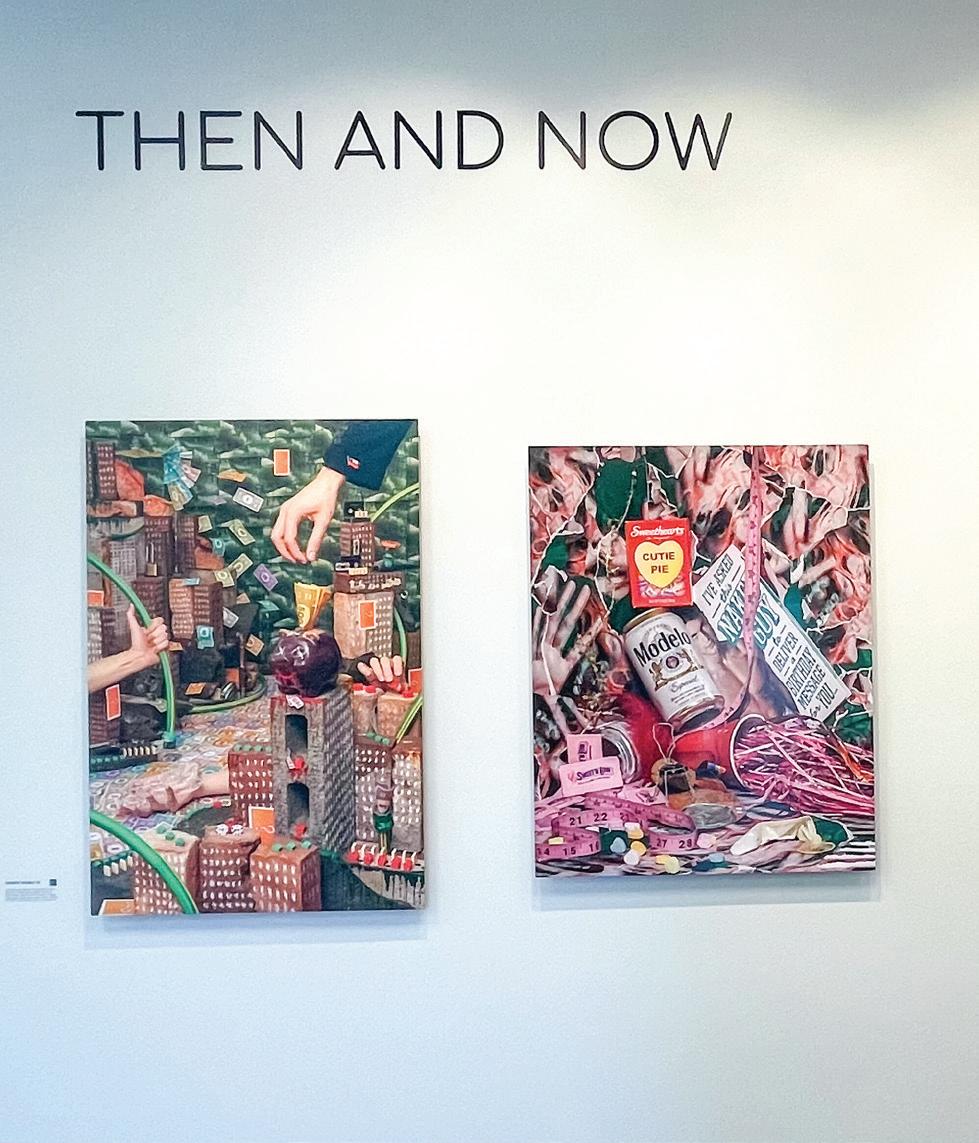
Forman, a 2006-22 resident scholar at the Women’s Studies Research Center, has art featured at the Museum of Fine Arts Boston and the Smithsonian National Air and Space Museum which showcases two silver gelatin prints that “challenged the notion that a photograph could only stop and isolate a moment in time.”
Forman’s recent work from 2012, “Carousel Escape,” depicts a carousel horse escaping a flooded circus tent, ment to express her stance on animal welfare and rights. “My images blur the boundaries between the real and the unreal. They are visual narratives that evoke a sense of transience, longing, memory and dislocation,” Froman writes in her artist bio.
Siporin’s art in the Alumni Art Gallery includes “Above and Below” from 1984 and “Portrait of My Mother” from 1974. One of her more recent works titled “Picnic, from Murals in the Marketplace Series,” was created between 2021-2022, inspired by negatives from her father’s trip to Mexico in 1939 that she had discovered. It was created with flashe, a vinyl paint, that allows for the bright orange, green and purples colors in the painting to come through. Klotz’s pieces are sculptural, one from 1984 titled “Charlie” and the other from 2019 named “We Wear It Away (Anyway).” “Charlie” was created during her time at Brandeis, in the sculpture studio, where she “sketched, observed, built armatures, modeled clay, direct-fired forms and made plaster casts.” She also gained skill of “Proportion, anatomy, gesture and technical craft laid the foundation” of her craft. “We Wear It Away (Anyway)” a four of a series of nine handmade abaca paper cast over family garments, which works to the narratives of the “storied garments” and “reimagine presence in the now.”
Grad’s two pieces include “After the Plague Party” from 2023, was inspired by art commissioned after historic plagues. Grad’s piece is part of a series that “find[s] a way forward after the COVID-19 pandemic” Additionally, “Confusion,” an acrylic painting from 1994-95, depicts bright colors and unique layers of marks and gestural line that Grad has been methods she has been exploring in her artwork since the 1990s.
Pressman describes his self portrait from 2006 and “Puerta del Sol” from 2015, as “documentation of [his] life” through diagrammatical art style. Swergold’s “The Embrace Series” uses organic and man-made materials to explore the “interplay of bodily existence in a realm of constant human interaction, both intimate and isolated.”
Cayuela’s “Golpe” created in 2023 and “Barely Legal,” created in 2021 uses archival pigment print on aluminum and natural wood. “Golpe” explores the anthropogenic climate change and challenges faced by Chile’s people, while “Barely Legal,” marked Cayuela’s journey into staged photography. In his own words, “It delves into themes such as queer identity, humor, self-discovery and the yearning for belonging.”
The Brandeis “Then and Now” exhibits will remain up until the end of March. In line with the plan of cycling the exhibits every six month, a new exhibit, titled “Joel Janowitz and Jenna Weiss | Connect 40” will be opening on April 11, featuring alumni artists Joel Janowitz ’67 and Jenna Weiss ’07 whose graduations are separated by 40 years. This will be in celebration of the Leonard Bernstein Festival of the Creative Arts from April 6 to 14.
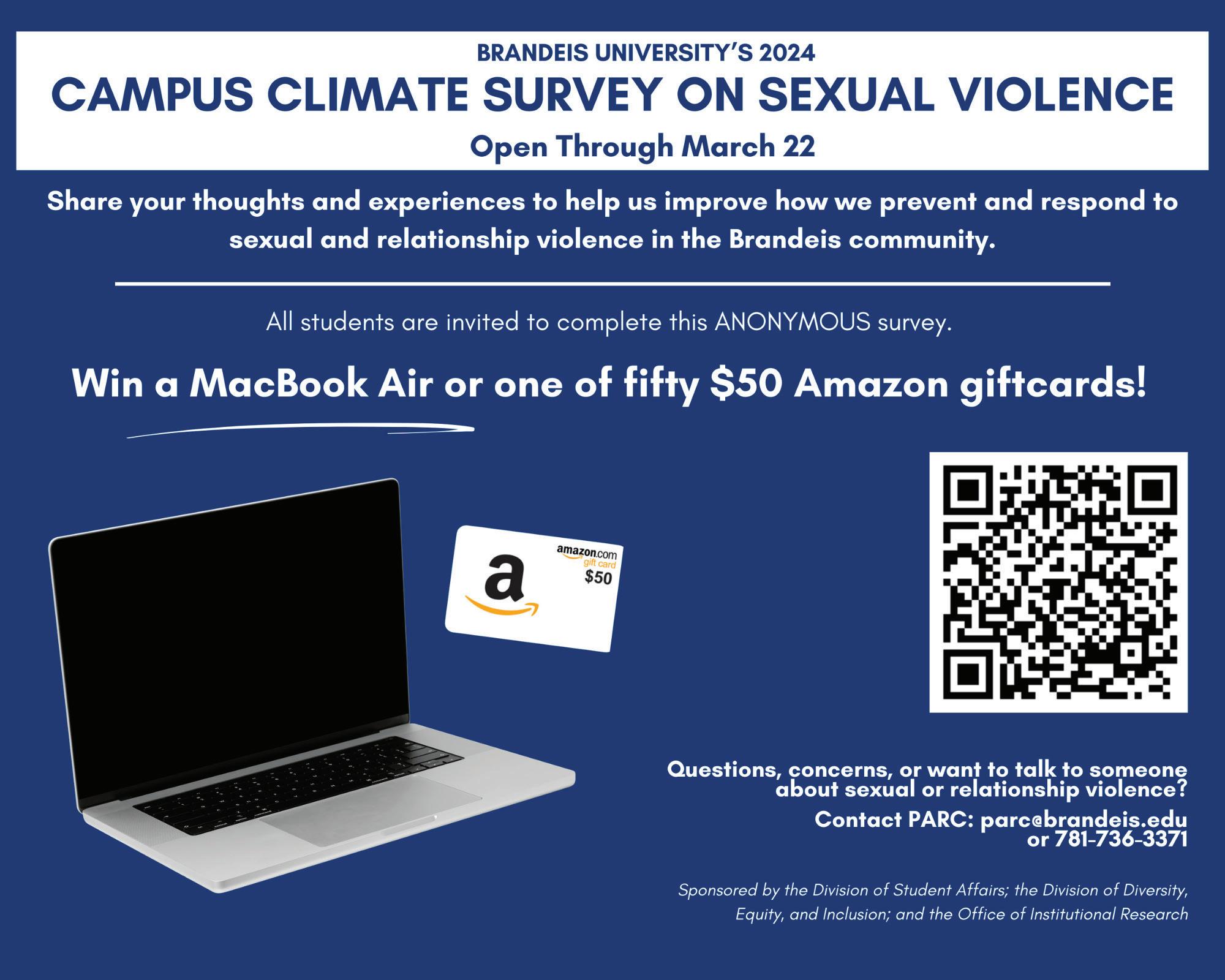


■ Led in conversation on March 13 by Prof. Naghmeh Sohrabi (HIST), the coauthors discuss their new book “How Sanctions Work: Iran and the Impact of Economic Warfare.”
By DIANE MEYER JUSTICE CONTRIBUTING WRITERSanctions have become “the tool of choice” for the United States in the 21st century regarding foreign policy. The U.S. government first imposed sanctions, defined as commercial and financial restrictions applied against states, groups or individuals, on Iran in the early 1980s after the country was designated as a state sponsor of international terrorism. The U.S. has increased sanction usage worldwide by 900% in the last 24 years. Narges Bajoghli and Vali Nasr’s new book, “How Sanctions Work: Iran and the Impact of Economic Warfare,” published by the Stanford University Press in February, explains how these sanctions have “permanently changed” Iran. In an online seminar on Wednesday, March 13 hosted by Prof.Naghmeh Sohrabi (HIST), director for research at the Crown Center for Middle East Studies and the Charles Goodman Professor of Middle East History at Brandeis, the co-authors took attendees on a deep dive into how sanctions have historically affected Iran and how they will continue to shape Iranian policy.
Bajoghli and Nasr are both professors of Middle Eastern studies, as well as of Anthropology and International Affairs at Johns Hopkins University. When asked why they decided to write the book, Nasr remarked that “policy conversation [about sanctions] is completely divorced from… [a] grounding in actual facts” and said that their goal was to “bridge social science learning with policy making.” They “recruited over a dozen economists and social scientists with experience doing research in Iran.” Nasr noted that sanctions have “often been studied with a focus on policy implementation … but that we do not have a comprehensive look at how sanctions affect the targeted society.”
Bajoghli stated that it was crucial for them to bring the discussion of sanctions, which is usually very abstract, down to the human level. “We often think about sanctions as the way in which they impact the behavior of a country,” added Nasr. Instead, he and Bajoghli have found that “in reality… sanctions are a powerful tool for state building… and have shaped the Islamic republic and its government in very fundamental ways.”
The U.S. currently imposes sanctions on Iran that ban nearly all trade – most notably targeting the energy sector, financial sector, and the
manufacturing, construction, shipping, mining, textile and automotive industries. In the book, which devotes a chapter to how sanctions have been implemented and increased over time, Bajoghli and Naserexplain that “when sanctions are developed in the interwar period…, [they] develop as a way to punish rogue states instead of sending troops.” U.S. foreign policy has adopted the use of sanctions with various restrictions in lieu of total embargoes in order to “seem more moral,” according to Bajoghli and Nasr.
This is a “question of semantics and discourse… a question of making these tools seem more moral,” according to Bajoghli. She believes that although targeted sanctions are meant to be different than broad based sanctions or embargoes, they end up functioning the exact same way in society. She attributes a “huge increase in the level of poverty” in Iran to sanctions, especially due to the Trump administration’s maximum pressure program.
Sanctioning Iran has led to an unforeseen consequence — “the creation of new social classes and new social bonds,” which is one of the main focal points of the book. Considering the significance of studying the social effects of sanctions, Bajoghli said that nothing can ever be studied in a vacuum. By “map[ping] the [social] effects of sanctions on top of everything else going on in the country, we’re able to put this research in [a] broader trajectory.” She described the changing society as an obvious and logical impact on the everyday lives of people.
Finding ways to bypass sanctions illegally is possible, but only available to people in the higher socioeconomic classes of Iran. Bajoghli explains that “the entire political culture [of Iran] is defined by not being bullied by the United States or the West… so [people] figure out [opportunities] to bust through sanctions,” which at their most profitable are only available to the political elite. “Doing trade becomes illegal [and] is a very expensive endeavor and carries with it potential criminal charges,” explained Bajoghli, “[you] need a lot of capital at your disposal… as well as the backing of institutions to engage in black market trade.”
This backdoor route for illegal business has caused high levels of corruption within Iran’s higher classes. Cash flows into the economy “that needs to be washed,” and this capital is often invested in the film and music industries, as well as businesses tied to the Islamic Revolutionary Guard Corps. There is no trickling down through the economy, so these opportunities for black market trade, made possible by working around sanctions, create a new higher class in Iran.
In contrast, the middle and lower classes in Iran experience a domestic scene with tougher access to goods. Many have fallen into poverty. Bajoghli said that this has turned a lot of people into laborers living off of day to day wages. However, a unique effect has been seen in that because of a lack of competition with foreign companies, “an autarkic economic system [has]
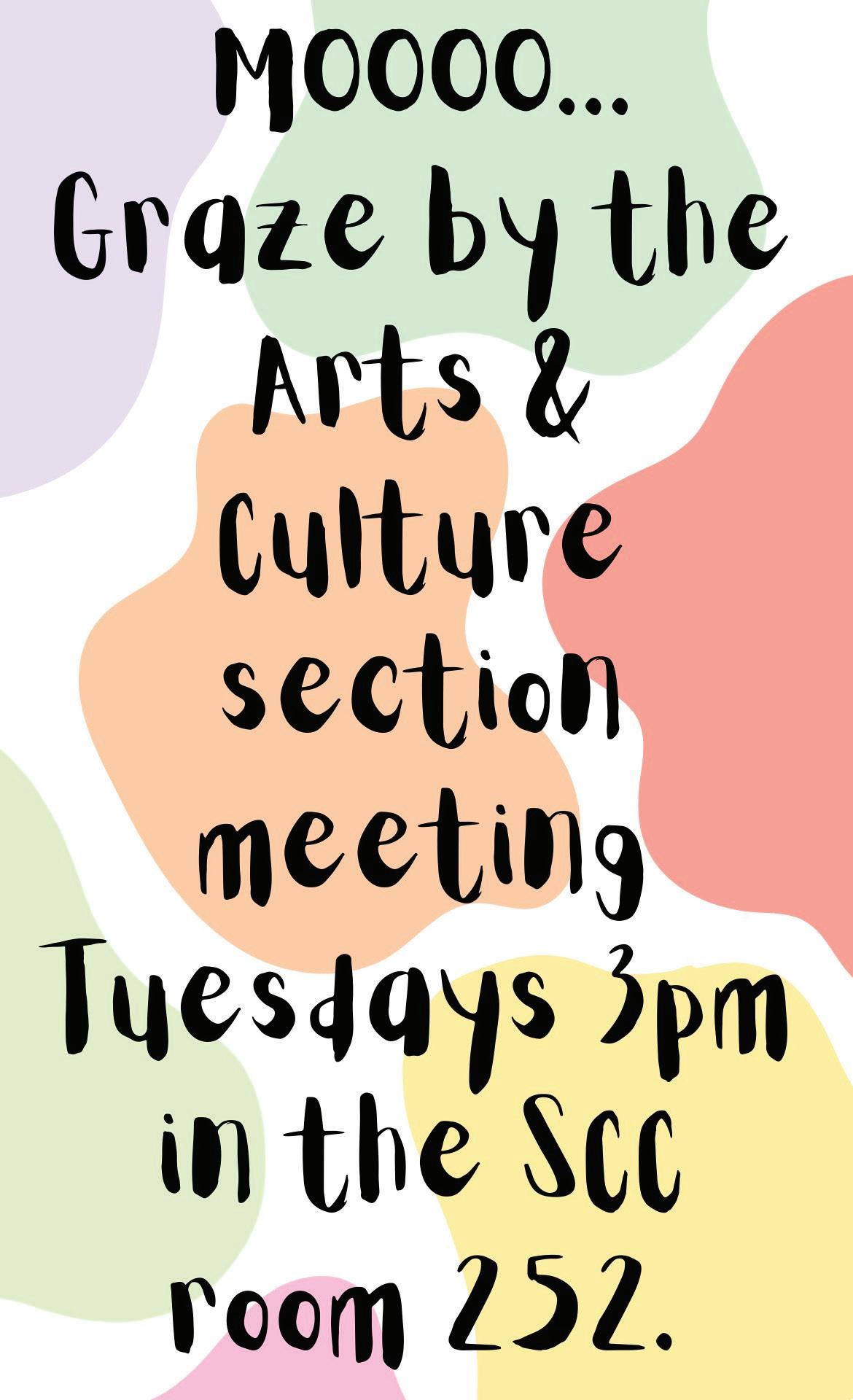
developed[ed], [with] smaller businesses run by younger folks using Instagram and Whatsapp.” The rise in micro businesses is especially seen in the fashion industry as Iranian small business owners do not have to compete with foreign brands.
Sanctions have locked Iranian society into an apparatus of economic disparity. According to Nasr, this “will not easily be changed,” as a wealth gap exists between the higher classes with access to “sanction-busting” financial opportunities and lower classes by less access to goods. “The financial network, [the] supply chain, and [the] trade mechanism in Iran, [is] now essentially all Iranian business is tied to,” and this isolation is profound.
Sohrabi wondered what state building veritably means as a consequence of sanctions, and Nasr’s point on the repercussions of Iran’s societal change is a fitting illustration: “The country has almost perfected the business of going around sanctions… [so] once the country as a whole makes massive investments in this mode of economic development, as flawed as it is…, its entire political economy and state structure [will] ... be woven around it.”
In regards to what sanctions on Iran mean for U.S. foreign relations, the sanctions levied on Iran have been deemed economic warfare by the Iranian state and this has hardened the political culture of the country. Bajoghli said that this response has only increased because of the maximum pressure sanctions under the Trump administration. Nasr states that sanctions “will only work if the other side calculates that if it changes behavior it will go away,” but even though he thinks that the sanctions against Iran are problematic, this is “not to say that sanctions are an absolute evil [if they are used correctly].”
Nasr elaborated on this tension, pointing out how the Trump administration’s maximum pressure sanction campaign was an erroneous attempt to sway Iranian behavior. Trump’s maximum pressure plan reimpose sanctions on Iran that had already been lifted when Iran met requirements, according to the 2015 Joint Comprehensive Plan of Action, or JCPOA, which involved multiple countries and was in the process of abating Iran’s nuclear capabilities. Nasr said that “after 2015, the understanding in Iran was that sanctions will never come off” even if they adhered to the JCPOA, which the Biden Administration did not rejoin. Rigorous sanctions will be maintained by the Biden Administration until Iran returns the full implementation of the deal.
However, Nasr believes that instead it will be impossible to get Iran back in the deal unless the U.S. lifts its sanctions. Bajoghli and Nasr recognize that taking a longitudinal view of history is necessary for understanding the effectiveness of sanctions, and this has ostensibly been forgotten by recent administrations in the U.S. Nasr said that now “Iran won’t go to the table because they have learned how sanctions work… [and] how [American] sanctions are sticky… [and]
very hard to remove because they become politicized.”
In the case of the U.S., the intent of sanctions is no longer clear in terms of the real effects on Iranian society. Nasr asked attendees of the seminar to question the goal of American sanctions on Iran — “are we just pretending that sanctions are doing something, or are we [imposing] meaningless sanctions… that sound good? Or are [we] using sanctions to punish or deter? Or [do we want] to change the regime entirely?”
If “the American political system is… paralyzed” and seemingly unwilling to lift sanctions, as Nasr said, “countries [will] begin to shape [themselves] around this reality.” Not only does this manifest unique effects on Iran’s economy, which have the potential to permanently shape the country’s financial systems according to corrupt black market trade opportunities, but Iran’s own foreign policy will become that of a country increasingly provoked by economic warfare. Bajoghli and Nasr emphasized that this needs to be taken seriously, as they believe that eventually this will escalate until Iran “respond[s] as if [it is] at war,” which is antithetical to the original intent of sanctions.
Sanctions are supposed to be an alternative to war — former President Woodrow Wilson famously explained that the U.S. should “apply this economic, peaceful, silent, deadly remedy” with “no need for force.” Bajoghli referenced this quote to illustrate how the reality of sanctions has become drastically different from how the countries imposing them once envisioned them. Sanctions have strengthened the Iranian state and intensified their military propensity while impoverishing its population. She argued that “sanctions are not an alternative to war — they have become the cause of war. We [can] see how Iran has developed its foreign policy…, creating [an] offensive force… [and] now you have a shadow war…[including an increase of] sanctions on countries allied with Iran.” These targeted states will push back and form their own alliances against the West.
Often the question is “do sanctions work?” said Bajogli. Instead of thinking about sanctions as impacting a country’s behavior in black and white terms of success according to the imposing country, she argued that especially in the context of American sanctions on Iran, sanctions should be thought about in terms of the political waves they create and how they work in terms of their lasting impact on society. As Nasr said, their goal is to “call for ways that sanctions as a tool have to be used differently if they are to be effective.” The seminar posed an introduction to Bajoghli and Nasr’s book and served as an illuminating discussion in its own right by assessing not only the ways that Iranian society is being transformed but offering an opportunity to consider the connection between social science and policy.
A video recording of the event is linked on the Crown Center for Middle Eastern Studies website.
On March 12, University President Ronald Liebowitz sent an email to community members outlining the keynote speakers and honorary degree recipients chosen for the 73rd Commencement ceremony on May 19. Documentary filmmaker Ken Burns and academic administrator Ruth Simmons will be delivering addresses and receiving honorary doctorates alongside women’s rights advocate Ruth Halperin-Kaddari and civil rights leader Roy DeBerry ’70, GSAS MA ’78, Ph.D ’79. Ken Burns has directed and produced “some of the most acclaimed historical documentaries ever made,” such as “Brooklyn Bridge,” “The Civil War,” “Baseball” and “Jazz.” Throughout his 40-year career, Burns has won 16 Emmy awards and two Oscar nominations. In 2022 he was inducted into the Television Academy Hall of Fame. He will be receiving the University’s honorary Doctor of Humane Letters.
As the President’s Distinguished Fellow at Rice University and a senior advisor regarding initiatives for historically Black colleges and universities at Harvard University, Ruth Simmons is a “higher education trailblazer.” Simmons was also the first African American president of an Ivy League institution, leading Brown University from 2001 to 2012 with unanimous approval. Additionally, Simmons serves on the boards of the MacArthur Foundation, the Smithsonian’s National Museum of African American History and Culture, the Holdsworth Center and the Hines Global Income Trust. Simmons will also be receiving the University’s honorary Doctor of Humane Letters.
Liebowitz clarified that Burns will deliver his remarks at the undergraduate ceremony in the morning and Simmons will address the graduate ceremony afterward.
According to her biography on the commencement website, Ruth Halperin-Kaddari is an “expert on family law and international women’s-rights.” Halperin-Kaddari is a professor of law at Bar-Ilan University in Israel and is the founding director of the Ruth and Emanuel Rackman Center for the Advancement of Women’s Status. She has served as the vice chair for the United Nations Committee on the Elimination of Discrimination Against Women twice. The University is recognizing Halperin-Kaddari’s career with an honorary Doctor of Laws degree.
Liebowitz highlighted that Roy DeBerry is a “triple Brandeis degree holder” and has served as both vice president and executive vice president for “economic development and local governmental affairs” at Jackson State University. He is also the co-creator of The Hill Country Project, a nonprofit organization that is looking to improve education and the economy in Benton County, Mississippi. Liebowitz wrote that DeBerry has been internationally recognized for his “publications and research in the areas of Jewish religious thought, ethics and modern Jewish history.” DeBerry will be receiving the Doctor of Humane Letters.
Lastly, Rabbi David Ellenson, the former director of the University’s Schusterman Center for Israel Studies and chancellor emeritus of Hebrew Union College-Jewish Institute of Religion, will receive the honorary Doctor of Humane Letters posthumously. Liebowitz wrote that Ellenson passed away shortly after he told him about the award.
“We are deeply saddened that we have lost David, and honored that his wife Jackie will accept the degree on his behalf,” Liebowitz said.
This year, the commencement ceremonies will be held in the Gosman Sports and Convocation Center.
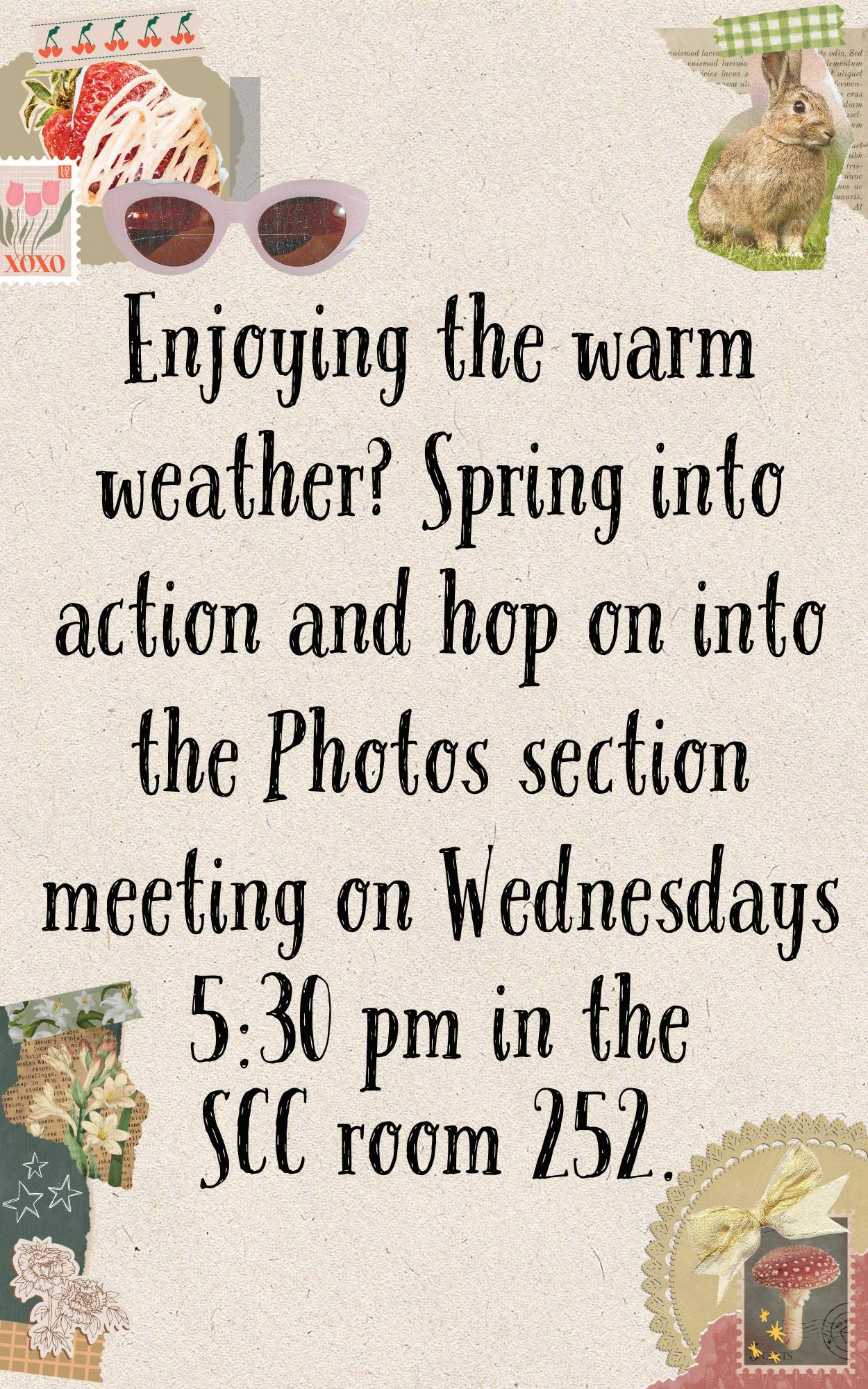
■ The Justice revisited archives of the police log from the year it started in 1993 up until the turn of the century in 1999. Here is a compilation of some of the most memorable reports that the Brandeis Police recorded in their logs in the ’90s:


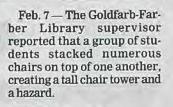










Whatever
In the 75th anniversary issue of The Justice, we look back to some lesser known moments of the University’s history as covered by our newspaper.By GRACE DOH JUSTICE EDITOR

April 1958: Early Justice April Fools Edition
As written in an April Fools edition of The Justice in 1958, then President Abram L. Sachar ordered for an issue of The Justice to be “confiscated.” It was of the paper’s first April Fools editions, which has since become a beloved tradition where the editors publish a thorough prankissue.
The front-page article in the 1958 April Fools publication wrote that the University had objected to a news article exposing an underground faculty organization called the “Freedom Fighters.” It claimed that security officers were ordered to retrieve “every last copy” of the issue from The Justice office to be burned. The issue was framed as an “extra edition,” that was distributed “only through clandestine arrangements on the part of the editors who, it is expected, will be expelled today on the recommendation of a faculty committee …”
They continued to write that to prevent any similar recurrences, Sachar organized a Faculty Committee on Censorship. With meticulous detail, the article made up accounts of student outcry to these events, such as the Student Council calling for a strike and the student body declaring a boycott of classes. In a cleverly righteous diatribe, the editorial board demanded for “renewed freedom for The Justice.”
“We have existed for ten years. This looks like our last issue for a while! But like other newspapers that have recently been suspended, we promise to return. We hope that in the near future there will be a reaffirmation of the Brandeis tradition of Justice—administration cooperation and mutual [interfertilization] of ideas,” the article concluded.
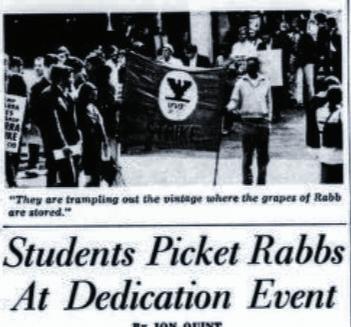
Oct. 1967: The Grapes of Rabb — Protest at the Rabb Graduate Center
The opening of the Rabb Graduate Center at the start of the fall semester sparked controversy due to protests against the Rabb family’s business practices regarding their Stop & Shop supermarket chain, which sold grapes from California farms
with poorly-paid migrant workers.
Picket lines formed outside the new facility, leading to weeks of fallout and debate. Some questioned the wisdom of the protest, suggesting it lacked prior dialogue with the Rabbs. The Justice published an opinion piece titled “The Grapes of Rabb” on the issue.
Irving Rabb expressed frustration with what he perceived as ingratitude from students, and the Rabb family’s association with Brandeis persisted. Norman Rabb, a trustee, and his wife were honored in 1990 with the establishment of the Rabb School of Summer, Special, and Continuing Studies.
Schwalberg noted that Sandel was an “unusually imaginative student.”
Now a political philosopher and lecturer at Harvard Law School, his course “Justice” is freely available online.
Nov. 1986: Oprah Winfrey lectures
Daytime talk show host and actress Oprah Winfrey made a visit to campus to deliver a lecture called “A Black Woman’s Plight for Success” in Levin Ballroom. In her lecture, Winfrey shared the struggles that she faced in establishing her career. According to a 1986 Justice article covering the lecture, Winfrey stated that “excellence is the best deterrent to racism.” Winfrey also spoke on how despite her lack of positive role models having grown up on a farm in Mississippi, she always tried to do her best in school and be resilient through the obstacles in her career in media. She ended the lecture with two pieces

Feb. 1975: Michael Sandel ’75 named Rhodes Scholar
Michael Sandel ’75, author of “Justice: What’s the Right Thing to Do?,” became the second person from Brandeis to win a prestigious Rhodes Scholarship. Notably, he was the first American citizen from Brandeis to receive this honor.
Sandel, selected as one of the four New England regional winners and one of 32 nationwide, went on to study at Balliol College, Oxford University. There, he pursued a combined degree in philosophy, politics and economics. Established by Cecil Rhodes, the scholarship provides $4700 per year for two years of study at Oxford University.
Sandel was described by his professors as “the epitome of the intellectual” and a student with his “own ideas and the courage to follow them up.” Professor Barney

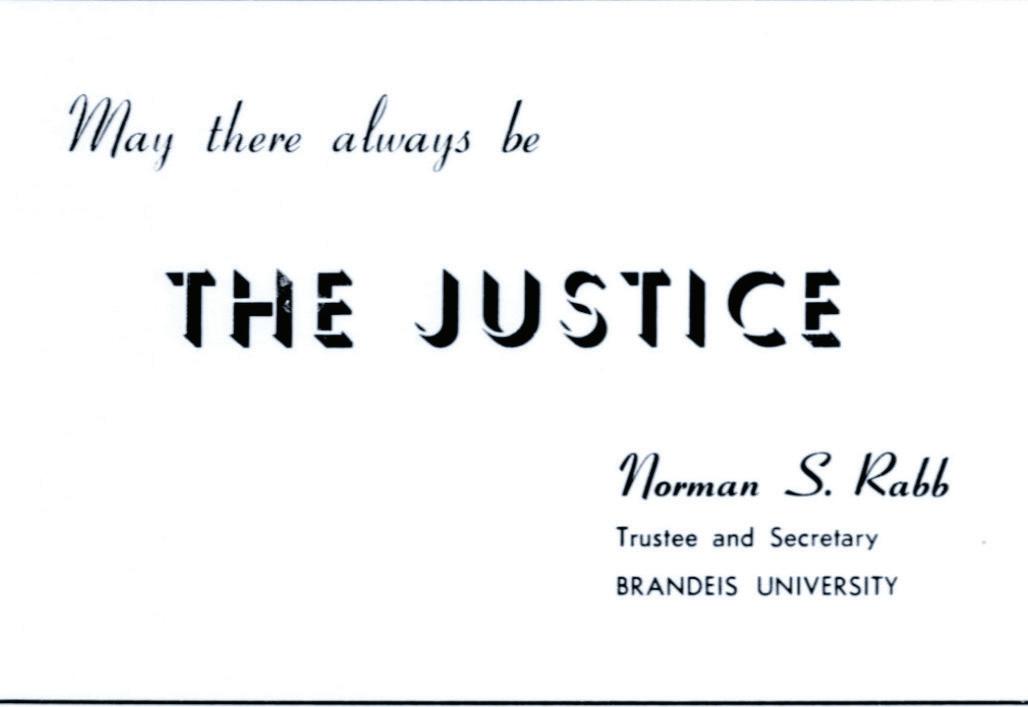
of advice to students: “Your heart always leads you in the right direction; listen to your heart, not to your head,” and “What you do will always come back to you, the good as well as the bad; what you put out, you get back.”
Sep. 1992: Shen Tong ’91 Detained in Beijing
According to a Sep. 8 1992 news story in The Justice, Shen Tong ’91 — a former prominent student leader in China’s prodemocracy movement — was arrested in Beijing just hours before he planned to announce the opening of a pro-democracy organization’s office in the city. Shen, who had returned to China at the government’s
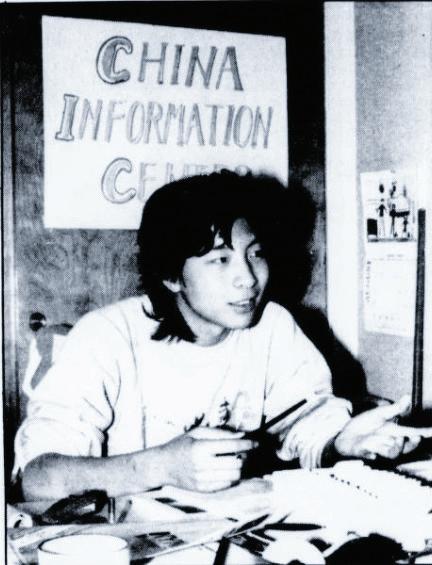
invitation after fleeing in 1989, was arrested in a police raid at his mother’s home.
The arrest occurred following a planned press conference, indicating Shen’s intention to continue his activism. He had traveled extensively across China to understand societal changes since the Tiananmen Square uprisings and had aimed to legally establish the organization’s office in Beijing. Shen’s arrest raised concerns about fabricated charges and potential imprisonment by the Chinese government. Despite his efforts for nonviolent transformation, Shen’s arrest exemplified the ongoing suppression of dissent in China.
The Brandeis community responded with rallies, petitions, and letters to local politicians. Then President Samuel Thier sent a letter to Senator John Kerry urging him to take whatever steps necessary to make sure Shen is fairly treated by the Chinese government. “We at Brandeis (and countless others) are concerned about Shen’s well being, especially in light of reports in (the Sept. 1 issue of the) New York Times of the torture of other pro-democracy campaigners imprisoned in northeast China,” The Justice quoted from Thier’s letter to Kerry. As a former Wien Scholar at Brandeis, Shen had advocated for democracy even during his time as a student and was recognized by Newsweek as one of the “People of the Year” in 1989. Shen is now an activist, entrepreneur and managing partner of FoodFutureCo.
On March 15, The Justice spoke to three members of the Brandeis Entrepreneurship and Tech Association about their experience visiting Silicon Valley over February break.
Over February break, while most students went back to their hometowns, 13 Brandeis students ventured into the Silicon Valley area — a worldwide hub of innovation and high technology. These students are part of the Brandeis Entrepreneurship and Tech Association, which aims to create a more entrepreneurial community, increase the ability of students to learn about how to become entrepreneurs, open up avenues for them to meet people who are working with a startup spheres and help students get recruited for jobs after college. It was chief operating officer Sarah Baskin ’26 and chief marketing officer Emily Wohlgemuth ’26 who brought the BETA dream of going to Silicon Valley to fruition.
“The idea was originally from the founder of BETA. It was always his idea, but then Sarah and I were put in charge of making it come to life,” Wohlgemuth said. Starting in September, Wohlgemuth and Baskin reached out to alumni through LinkedIn, alumni relations, the International Business School and the Hiatt Career Center.
The trip was primarily free, the club’s budget covering flight and lodging expenses with only a few out-of-pocket food expenses.
“One of the goals that Emily and I had for the trip from the onset is that we wanted to be as accessible to people as possible.
A lot of people who could 100% afford all the aspects of this trip, they would have access to so many other networking opportunities and already have these connections existing. We wanted to open up this opportunity to people who potentially wouldn’t have those connections already, the resources, and we wanted them to have these sort of life-
changing experiences,” Baskin said.
Jia Zheng ’26 is a double major in Business and Psychology who joined BETA last semester. Zheng joined BETA in hopes of getting a feel for different fields and industries in the business world.
Zheng explained, “From my perspective, [being] first-generation in my family … and being on this trip was really impactful for me. I was able to visit a place on the opposite side of the country, which is really transformative.”
She added, “Having expertise and advice from the professionals was really helpful because it really made me think outside the box.”
Being in Silicon Valley allowed Zheng to realize that she best thrived in the city, where she could continue to feel motivated.
Regarding initial expectations of the trip, Zheng mentioned that she did not know most of the people in the traveling cohort and simply looked to have some fun and develop her professional skills. Zheng commented, “I wanted the trip to be a challenge for my personal growth, in terms of having soft skills, speaking and talking to other people, visiting companies and getting a feel of how it is.”
Baskin mentioned that as a planner of the trip, her biggest expectation was, “for everyone to just have a good time, to get everything that they could out of the trip, to really make connections with the alums [they] had lined up and potentially see what field they would go into, perhaps be inspired by a field they hadn’t put much thought into previously.”
As a personal goal, Baskin was highly interested in the companies that matched with
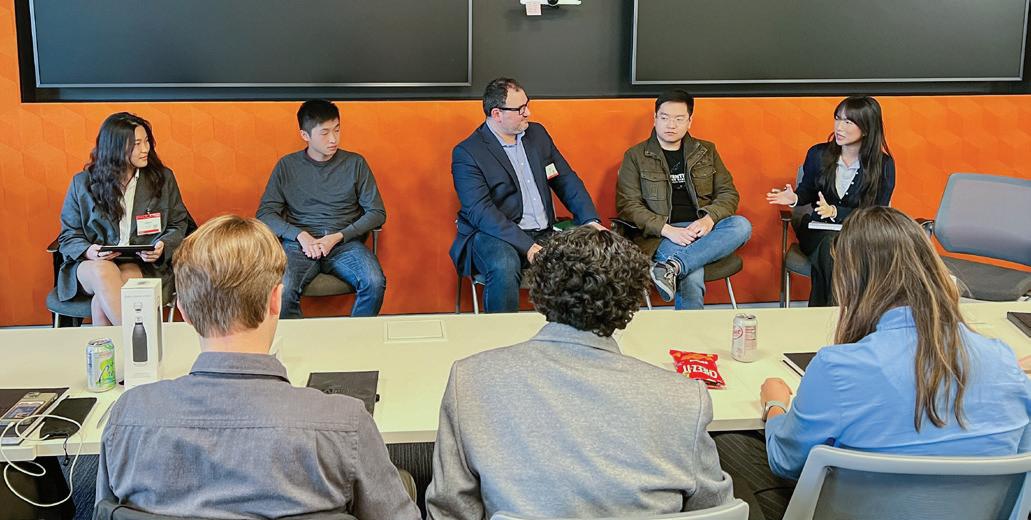
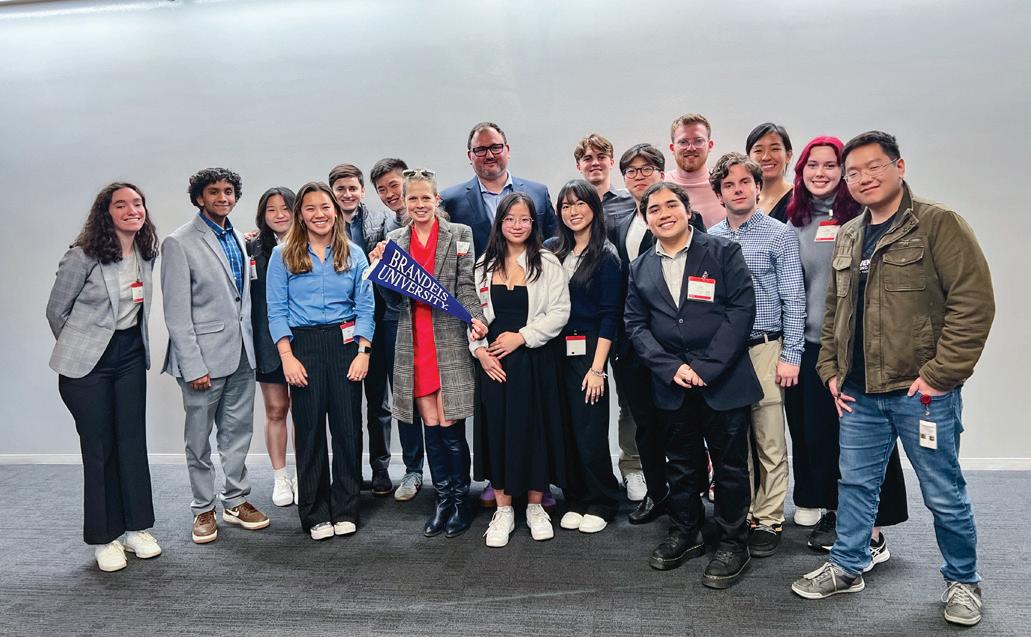 By RIA ESCAMILLA-GIL JUSTICE STAFF WRITER
By RIA ESCAMILLA-GIL JUSTICE STAFF WRITER
her own personal interests and talking with others that focused on things that she wanted to do. She emphasized that her personal goals were secondary and that she wanted to prioritize the experiences that everyone had and make sure that the trip would go smoothly.
Agreeing with Baskin, Wohlgemuth stated, “I always made sure to check-in with people individually, that they were enjoying it and that they were actually getting stuff out of the experience,” having planned the trip’s itinerary according to the students’ common interests such as product management.
“I would say that we succeeded in that,” Wohlgemuth reflected. Zheng made unforgettable connections with many throughout her Silicon Valley visit, such as a senior manager at Google, Yiran Li. The manager she was able to connect with was also an international student, to which Zheng added, “It made me feel really connected because we are of similar backgrounds, I was able to connect with her via LinkedIn. It was a really big help.”
Wohlgemuth enjoyed connecting with other Brandeis alumni such as Tina Snow, who is currently working at Google: “That was definitely a highlight for me. We were really happy to get a visit that was all women in the panel discussion, that brought a really integral perspective to all that we were doing there while in Silicon Valley.”
For Baskin, the most memorable company visit was Adobe, where students were able to speak to not only alumni but current employees, playing games with them, getting their ques-


tions answered and networking. BETA members were also able to meet Adam Cheyer ’88, co-founder of Siri, during their
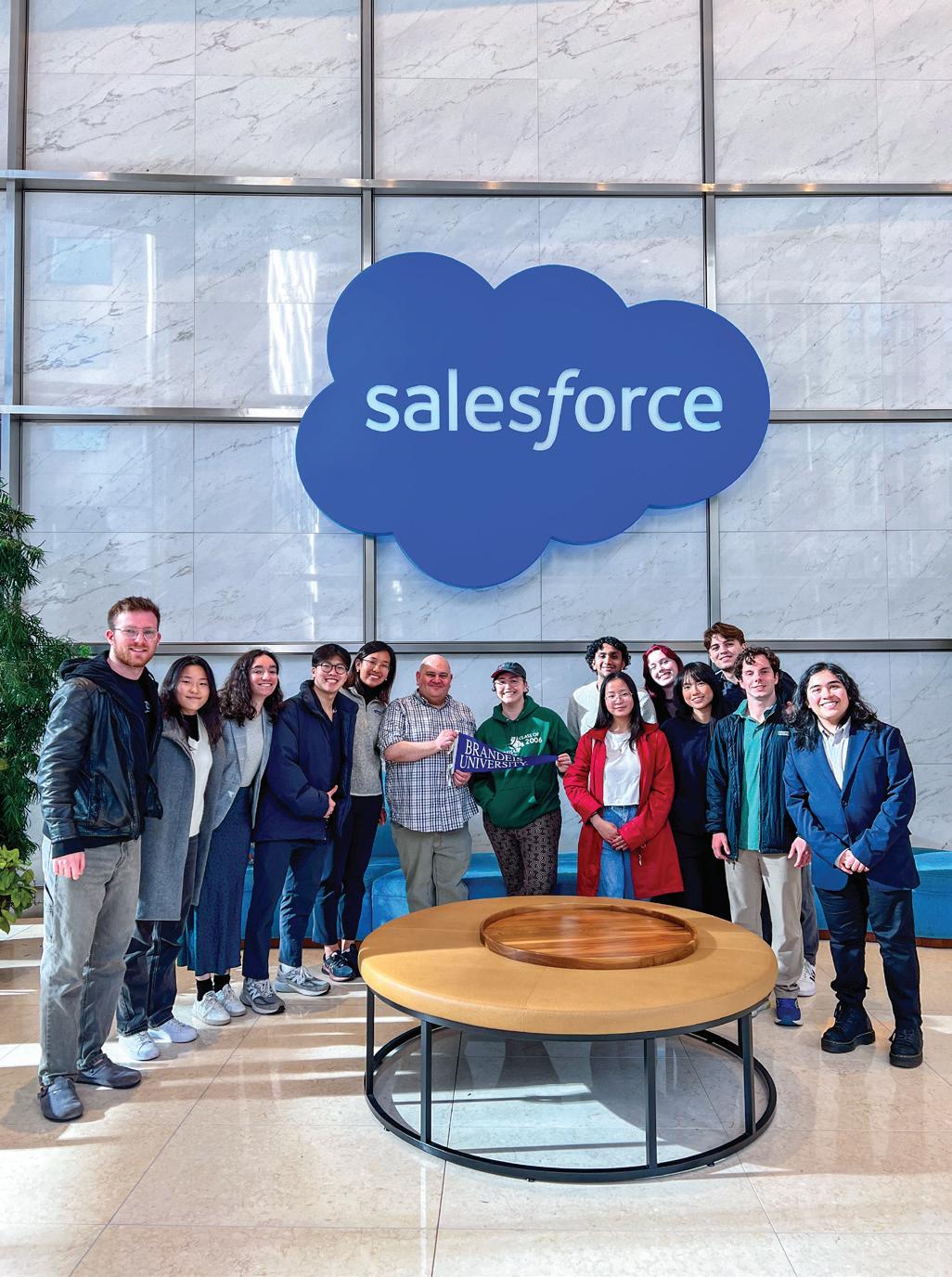
Airbnb visit. Zheng noted that she appreciated how humble and down-to-earth Cheyer was: “That is not something you really get when you hear from executives, and it was really heartwarming.”
One of the fondest memories for everyone on the trip was a serendipitous visit to the Golden Gate Bridge, where members took pictures and enjoyed their last day in San Francisco.
Reflecting on their experience of the five-day trip, Wohlgemuth said that the most surprising thing was that “at the end of the day, after visiting out all of these companies and successful people, the things I got most out of in the trip were from the other people who were there with us, people from Brandeis I had never met before.”
Baskin shared that she learned a lot in terms of career paths and how different they can look: “There is no one path, there are so many ways to get the career that you want.” Wolgemuth also appreciated this insight from the trip, feeling less pressure on the question of “what you are doing now as to what follows after.”
Echoing these statements, Zheng remarked, “You don’t really know where life is going to take you. You might meet someone who will change your life.”
Isabel
Eliza Bier, Anna Martin, Lauryn Williams, Deputy Editors
Owen Chan, Ceci Xilei Chen, Zachary Goldstein, Julia Hardy
Mina Rowland, Associate Editors
Sophia De Lisi, Anika Jain, News Editors
Grace Doh, Features Editor
Rani Balakrishna, Sports Editor
Nemma Kalra, Arts & Culture Editor
Jonas Kaplin, Bryan Wolfe, Photography Editors
Sarah Samuel, Madison Sirois, Copy Editors
Marina Rosenthal, Layout Editor
Elizabeth Liu, Ads Editor
Amanda Chen, Eden Osiason, Online Editors
Since the founding of The Justice newspaper in 1949, student journalists have worked diligently to cover topics that are important to the Brandeis and Waltham communities.
From our coverage of the 11 day sit-in for equity and inclusion at Ford Hall 1969 and 2015 protests to the Brandeis workers protest, the paper has been a consistent and reliable source for students and community members to turn to.
The production of the paper is not always easy; it requires dedication and mustering through the late nights of editing and revising. However, if you ask our staff they would say it’s worth it.
To hold the final copy of the paper in our hands, to see people on campus flipping through every page is incredibly gratifying. Over the years, The Justice has received recognition from Columbia University’s journalism program, Change.org, the Boston Globe and more. It not only has been able to reach Brandeis but serve the general public as well.
As we held the 75th anniversary of The Justice celebration last October, our office flooded with past editors and writers from the classes of 1999 to 1960. They joyfully recalled the nights in the office and their favorite stories they had written. While not every former staff member of the paper has gone on to a career in journalism, they expressed that this work not only provided them with a sense of community but it also allowed them to develop their sense of self and voice. Reporting encourages you to engage with our community in a meaningful way, by spending time with interviewees and crafting questions to get the best quote or capture memorable moments. It also nudges you out of your comfort zone whether
that be pestering admin for a quote, reaching out for interview requests or traveling across the city for a story. While it might seem daunting at first, the more you don a press pass it becomes exhilarating.
So, as we celebrate the 75th edition of The Justice, we would like to take this opportunity to thank past editors and contributors, whose work paved the way for us to thrive as a publication today. In the past, crafting the paper was a painstaking process — editors had to print the paper from an office in a building that does not even exist at Brandeis anymore. However, thanks to their enduring dedication, 75 years of Brandeis history, culture and news have been documented, with many more stories yet to unfold.
On our campus, there are over a dozen events going on at any given time, with countless new stories to be unearthed. Every publication is an opportunity for us to highlight the remarkable efforts of students and faculty, while also critically investigating the realities of life at Brandeis. Therefore, as we move forward, we do so with a deep appreciation for the efforts of Justice alumni. The 75th anniversary edition serves to both celebrate our achievements and commitment to student journalism and to honor the legacy of perseverance that defines The Justice.
Finally, this editorial board would like to take the opportunity to thank all of our past, present and future readers for placing your trust in us. We work tirelessly to craft an ethical and reliable publication, and we do not take your ongoing support and confidence in us for granted. Thank you for being a part of our journey, and here’s to many more issues ahead!
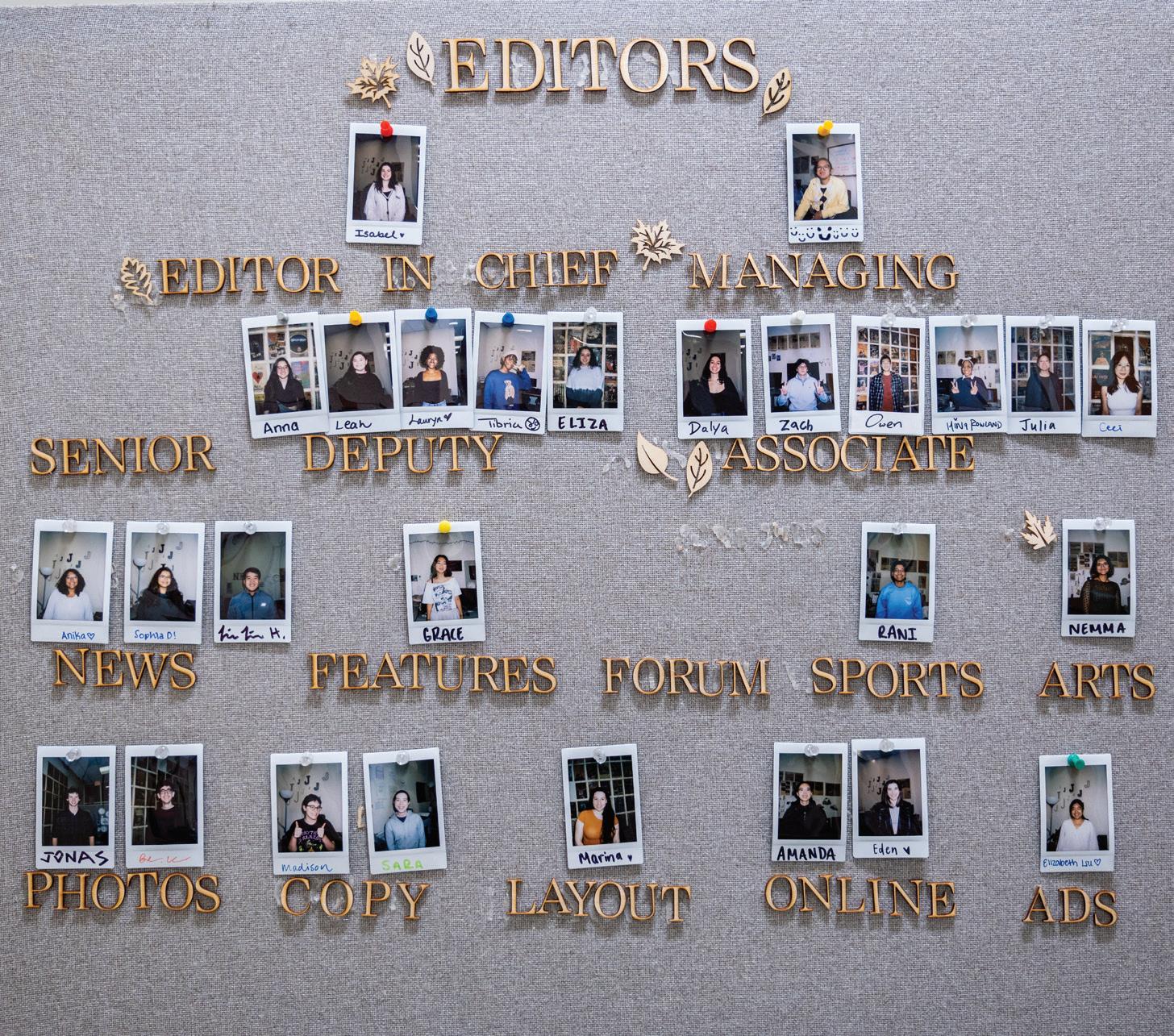
THOUGHTS ON “The Justice’s” 75th Birthday Richard H Weisberg (*)
Marty Fassler and I co-edited the paper in 1964-65. Those were frenetic times on campus, capping a four-year battle with the founding president, Abram Sachar. Everyone with eyes and ears – including the keen reporters and writers for the JUSTICE – saw that the University was in full conformist mode. The liberal and even radical policies at the immediate postwar origins of our school, which sheltered exiled European intellectuals and domestic talent that found no other comfortable home, were “transiting” to the flabby mediocrity of a place that no longer wished to be identified as a leader in social criticism, literature, history of ideas, or left-wing writing of any kind. Sachar instead turned his aging head to the emerging neo-liberal norms epitomized by JFK: style over substance, a subdued and barely visible allegiance to racial justice, misogyny masked as “Camelot”. Sachar wanted a campus that would become quiescent in the intellectual , the moral, and the political sense.
He had already fired Kathleen Gough Aberle, a feminist and rising academic star who publicly supported Fidel Castro over Sachar’s darling JFK during the “Cuban missile crisis” of 1962. He had put teeth in the absurd parietal rules that (unsuccessfully) kept boy from girl in the Castle and other campus trysting spots; he had contemplated censoring the JUSTICE itself and had to be subdued by that hardly radical thinker, Max Lerner (so went the rumor: it might have been John Roche who managed to make Sachar see the light on this occasion).
We would have none of it. We warriors, we who had chosen Brandeis over the Ivies, we who adored the school – this editorial “we” launched into a year-long polemic against Sachar and his perceptible move to eviscerate what had made Brandeis terrific. Herbert Marcuse was, in effect, fired; that is, the University would not match a modest increase this intellectual giant at age 65 had received from remote places out West he could not even identify on a map much less home down in for his still-productive dotage. When asked by JUSTICE editors how in hell (we used a stronger expletive) he could let this central campus intellectual figure go, Sachar replied – dodderingly – “We don’t know what Marcuse’s health chart will be over the next few years!”.
Yes, our swan song (the final editorial was captioned “Good Night, Sweet Prints”) gave the “radical polemic” its last ride……But the University was “hell”-bent for its middleyears meltdown.
I have never fallen out of love with Brandeis, which was the place to be in the early ‘Sixties. Decades later, at my urging, a nephew attended and excelled. I taught in the English Lit department around that time. I have been the law professor of many stunningly smart Brandeis alumni. I offer this semester a Brandeis on-line (“BOLLI”) course for adults, which I call “Shakespeare Sides with Shylock”. I contribute faithfully to my alma mater. I follow the successes of many who came after me to get their B.A.’s from the school, and I bemoan those among them who have gone so horribly wrong, like Thomas Friedman, that subsequent JUSTICE editor who has enthusiastically led his paper’s attacks on Israel from Oct. 8th to the present, quickly forgetting who bloodily started this tragic conflict. History will come to define the pejorative term “moral equivalency” by citing the NYT editorial and “news” pages during the Israel-Hamas war.
I thank this year’s editors for giving me this chance to replicate our campus newspaper’s mantra from the ‘Sixties: “Once more onto the breach, dear friends! Once more!”.
(*) Weisberg and Fassler’s heated editorials of the early ‘60’s, like the full JUSTICE numbers from those and other years, are available on line.
Richard H Weisberg Brandeis class of 1965
I was editor of The Justice from January 1964 through January 1965, sharing the position with my friend and classmate Richard Weisberg during fall semester 1964.
Working on The Justice from 1962-1965, I had fun, gained competence, confidence, and began transitioning to adult responsibilities and the responsibilities of journalism.
The editors who preceded me were Arnie Reisman and Steve Slaner. Editorial board members that I remember were Celia Ussak, Jane Margold and Jeff Cohen. We spent most of Sunday laying out the paper, Monday evenings reading proofs from the printer, Tuesday mornings at the Boston print shop overseeing corrections, revisions and late additions, and Tuesday evenings at a meeting planning the next week’s edition. There was a plenty of laughter at each event.
Of course, the mid-1960’s was a period of considerable social change and accompanying tumult. In one issue, we ran on the bottom of the front page an article about the NAACP picketing a few Stop and Shop stores because of the chain’s allegedly discriminatory hiring practices. At the time, the chair of the Brandeis Board was a prominent member of the family that owned Stop and Shop, and was a high level officer of the corporation. We editors felt that the Brandeis connection made that a story suitable for The Justice. The Dean of Students then called me in and told me to write a letter of apology to the board member. With mixed feelings, I did.
In spring 1964,we published a brief letter to the editor from a graduate student, inviting Brandeis students to join him on a planned trip to Cuba, which had been through its revolution a few years earlier, led by Fidel Castro. Shortly after that, the FBI called me to ask what I knew of the graduate student. I told them, truthfully, that I had never met him.
The Viet Nam war was heating up. One Monday night in the fall of 1963, Madame Nhu, sister-in-law of South Viet Nam’s dictator, was to speak at the Harvard Forum, a well known “town hall” type event in Cambridge. The editors of The Justice asked me to attend the talk, and prepare a report for inserting in the paper the very next morning - just like a real newspaper reporter. I did it, proudly. One questioner asked Madame Nhu to justify the harsh oppression of Buddhist peace advocates in Vietnam by her brother-in-law’s government. Her response was “You can’t make an omelet without breaking eggs.” That was in my article, which was published by The Justice the next day.
In the fall of 1964, President Sachar called a convocation, in the largest auditorium on campus, specifically to criticize The Justice. I do not recall what angered him so much. Perhaps it was about this: when the Faculty Senate was considering some major change in the academic structure, a faculty member with whom I was friendly showed me, in his office, a copy of the internal faculty memo outlining the proposed changes - and then left it on his desk and walked out of his office. We ran a lengthy story about it. At any rate, the convocation was a tempest in a teapot. Nothing came of it.
I hope the current Justice staff is having as much fun as I did during those years.
Marty Fassler



Brandeis class of 1965
FYI: After Brandeis, I attended Columbia’s Graduate School of Journalism, a 1-year M.S. program, then worked for the Quincy, Mass. Patriot Ledger, then the Sacramento Bee, then began law school at Berkeley in fall 1969. I worked as a lawyer from then until recent retirement. While in law school, I wrote a few free- lance pieces, for the Boston Phoenix, and for a magazine no longer in existence, called, I believe, Juris Doctor. As a lawyer, I was managing editor of the California State Bar publication for labor and employment lawyers, 1998-2004. Since retirement from full time work, I have written a few articles for other State Bar publications, including one about how California law about government employee ethics would apply to some of the shenanigans of the Trump administration.
On March 3, over 80 Brandeis Posse scholars, their guests, called “pluses,” and various faculty members attended the annual Posse Plus Retreat held at the Sons of Italy Function Hall in Watertown, MA. On the Brandeis website, the Posse Program is described as a “merit-based scholarship program.” As Posse scholars, students are “expected to be not only strong students but also demonstrate outstanding interpersonal and problem-solving skills,” with an emphasis on leadership skills. These attributes were all evident at the retreat titled, “Education Recalculated,’’ which ended up focusing on various troubling topics pertaining to Brandeis University.
The retreat is an annual event and an expectation of the scholars, who often are asked to take time off of work and school to attend. Attendance at PPR is an expectation of the Posse Program and students who are unable to make time for the event risk losing their full-tuition scholarship.
After a series of icebreakers, an activity dubbed “the human barometer,” sparked the discussion that occupied the remainder of the day. On one wall a sign was posted that said “strongly agree” and on the opposite wall a sign was posted that said “strongly disagree.” The event organizers provided various contentious statements and students would arrange themselves according to their personal beliefs, with some students volunteering to give their reasoning for their placement. For example, one student said, “I believe the cost of college is worth the benefits.” During this activity, Brandeis University president, Ronald Liebowitz, entered the function hall. President Liebowitz has attended PPR for a commendable duration of the event in the past few years.
This year, however, Liebowitz was noticeably absent for the first couple of hours of the retreat. The statement “I believe there should be limits to free speech on campus” was given and a scholar directed a question to President Liebowitz inquiring how he has developed an understanding of free speech as it applies to Brandeis University campus. Liebowitz chose to make a clarification between free speech and “gratuitous speech,” later defining the term as actions that don’t further a discussion*. The retreat then shifted to a roundtable discussion that included the voices of both the administration and students as it pertains to free speech conversation on campus.
Some of the students directed questions and statements to President Liebowitz and some spoke more generally to the other attendees. After approximately 20 minutes of discussion, a three-minute break was called, much to the protests of the students who had been waiting patiently for their turn to speak. The event organizers announced the break as a way for them to regroup and readjust their programming. The break was then extended to 10 minutes. During the break, a multitude
of scholars witnessed President Liebowitz fleeing the building — running down the stairs to the exit after spending merely twenty minutes of the eleven-hour event in attendance. His dramatic exit offended nearly every person in attendance, as he demonstrated an unwillingness to listen to student voices. His supposed support of free speech became ironic as he was unable to merely sit and listen to students speaking freely. Instead, he took the first opportunity to leave the discussion.
We received statements from five students who attended the event, some of whom chose to remain anonymous. Many students at the event felt that the voices of students with views that differed from the Brandeis status quo were being silenced, as freshman E.O. explains: “Our university, in particular, is at a time where the political climate is tense,” however, “we should be about to feel free when speaking about things that concern us on our campus.” In response to the discussion sparked around free speech, sophomore H.A. stated “These discussions, which were previously whispered about around campus out of fear, have now come to the forefront. Enough is enough, and [we are] relieved that students on this campus were provided with an uninterrupted platform to express their concerns to Brandeis faculty, staff, and administrators.” E.O. claimed that “the discussion we had needed to happen, as a lot of students seem to have this sort of inner grievance with the campus and certain rules that were set in place and certain actions of board members, so I would acknowledge how it was destined to happen, but the POSSE retreat was simply a catalyst.”
The silencing of pro-Palestine voices was a main topic of the free-speech conversation with senior K.B. adding “How [Brandeis administration] have chosen to respond is in complete contradiction to a “social justice university,” a claim of free speech and protection… this school will forever be a contradiction due to the way Ron and administration have addressed the matter and protests.”
There was a discussion on the protest and subsequent arrests that occurred on the Brandeis campus in the fall semester with K.B. addressing the concerns of students about “the deprivation of education that [President Liebowitz] supports both globally and here on campus” regarding “those who were wrongfully abused and arrested.” The general consensus pointed to a necessary discussion around topics such as the IsraelPalestine Conflict and the fearful attitudes around the supposed “free speech” on campus.
Eventually, the participants moved the discussion towards the lack of community on campus. Posse, an organization founded for the purpose of uniting students, was almost unanimously regarded as having a lack of presence on campus. One scholar shares, “I don’t know if posse has a stronger presence on other campuses, but I do feel that it lacks connections and its presence on the Brandeis campus,” effectively summarizing
The opinions expressed on this page are those of each article’s respective author and do not reflect the viewpoint of The Justice.
The year was 1965 and two memorable issues were a special edition with professors debating the Vietnam war and an April fool’s issue based on the National Enquirer (“the National Perspirer”), with a huge formal picture of the then famously gruff and intimidating university registrar and the headline: “Charles Duhig confesses: I am a woman!” Pretty much everyone on campus was amused, save Duhig.
A columnist, Mark Kramer, went on to write numerous books and teach journalism at Boston University. For me, it was the beginning of what has turned out to be a 54-year career in journalism which remains ongoing.
Paul Solman, BRANDEIS ‘66, business and economics correspondent for OK the PBS NewsHour (originally, the MacNeil/Lehrer NewsHour) since 1985
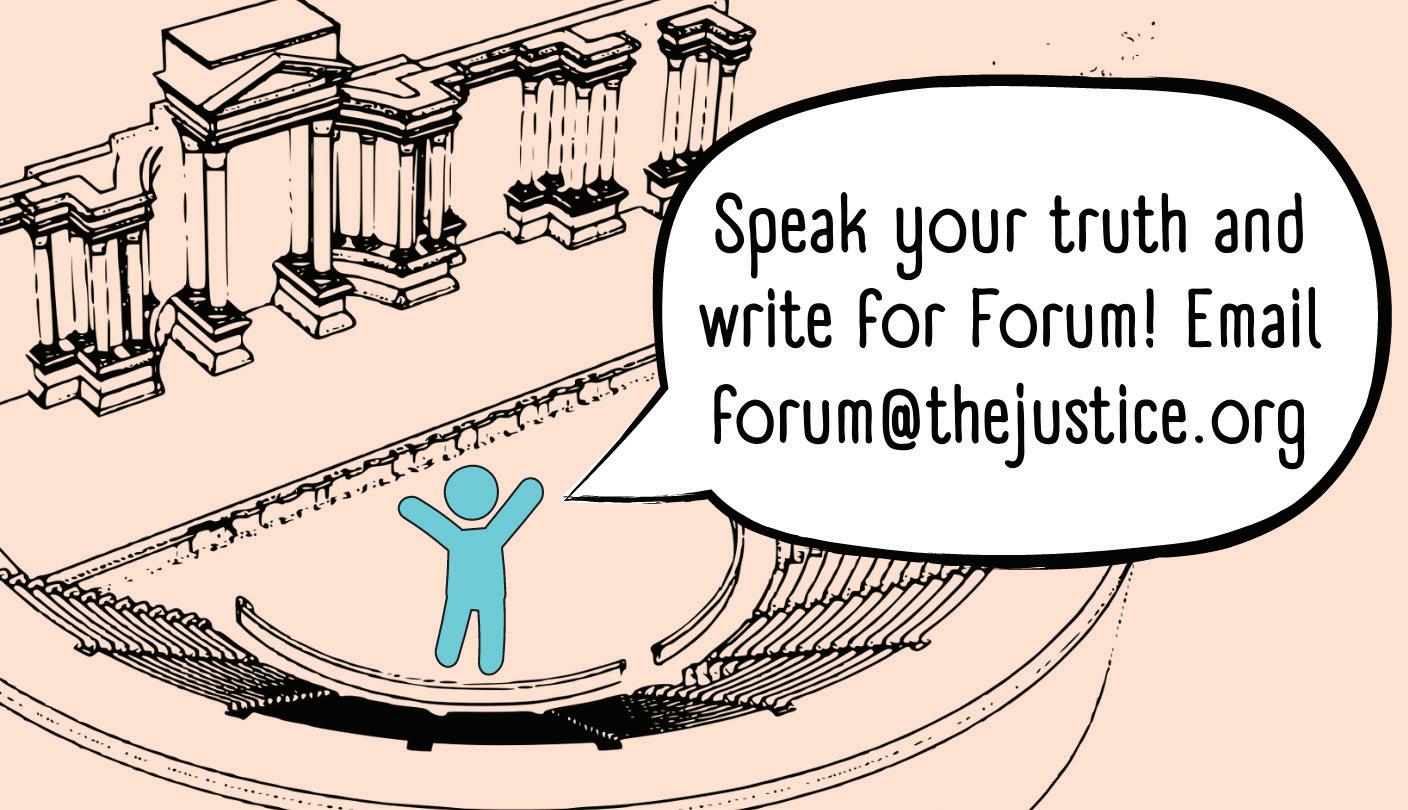
the feelings of the group present on the day of the retreat. Similarly, another scholar shares that “Brandeis in specific lacks to support Posse Scholars.”
As a result, the annual Posse Plus Retreat acts as one of the few spaces at Brandeis where scholars have a space set aside for community engagement. This also means that this is one of the few spaces where scholars discuss shared experiences and commune in their struggles on campus.
Yet, many students left the retreat feeling that an “event full of POC ask[ing] challenging questions of Brandeis’ President…were quickly and resolutely silenced by representatives of Posse National (anonymous).”
In summary, Posse students lack a space to share their experiences, and when they do have a space to speak with each other and administration, their concerns are effectively silenced. BAP 10 Scholar, K.B., shares, “Students are suffering, we are hurting and have been for a very long time, yet we have no support promised to us by those who claim to be leaders themselves,” exemplifying how issues of free speech and safe spaces on campus are timely and pressing.
Furthermore, the Posse Plus Retreat is a space that represents a large population of Black and brown students. Brandeis, as a predominantly white institution, rarely holds formal spaces where Black and Brown students can convene and speak about their shared experiences.
Many scholars found that “the Posse retreat was simply a catalyst” for discussions that have been brewing on campus in underrepresented areas (E.O.).
The discussion and abrupt departure of President Liebowitz left many with the feeling that, “at a PWI, it often feels that certain voices are amplified more than others (anonymous).”
Additionally, E.O. continued to illustrate how “Posse accounts for a lot of the diversity on campus, and it’s very essential for our voices to be heard and for ideas we proposed to be decentralized,” adding to the idea that POC students aren’t given the space to voice and share their concerns in the same way that white students on campus are.
K.B. also addressed how the administration is to blame for these patterns of discrimination on campus. The scholar shared this statement about President Liebowitz’s abrupt departure, “The visible privilege to be able to just leave — because those in Palestine cannot, nor did I in my four years of struggling in university here — and the lack of concern for a space of majority Black and brown students made me so angry.”
They reflected on their time here as graduation creeps closer, saying, “The university associated with this diploma will mean nothing to me once I have graduated but rather a symbol of my ability to overcome all of the hurdles that white supremacy has strategically set in front of me for the entirety of my life. Brandeis’ administration has terribly failed!” (K.B.) K.B.’s comments speak to another discussion that occurred at the retreat directed at the administration’s
response to the contemporary issues of mass murders occurring in Palestine. K.B. leaves us with the thought, “It will take diversity and erotic thought that Black and brown students bring to universities, one day he will need us as a leadership-based scholarship and we will never forget how he wasn’t a leader when we needed him.”
Before his exit, President Liebowitz invited the attendees to visit him in his office to address their concerns, however, many students felt this was an insufficient solution. K.B. felt the invitation was a “suggestion of more labor” and that “his office was not a safe space.”
One anonymous scholar explained that the opportunity presented by PPR “to have a discourse off-campus leveled the ‘playing field’ substantially” and the discussion happening in President Liebowitz’s office would have an enormous power imbalance that has the potential to hinder free speech due to fear of repercussion. K.B. shared the sentiment that his invitation made it feel “as if our presence here and courageous acts of involvement here was not enough, because he refused to acknowledge it.”
An anonymous student summarized “The fact that the president walked out while everyone was trying to state the issues on this campus…was very disrespectful.” Branch adds “His presence was performative and his absence was cowardly.” Overall, President Liebowitz left students feeling shocked, disappointed, hurt, and offended by his inability to participate in a discussion as important as the one had at PPR.
The resilience of Posse students shines through even after a tumultuous PPR. In direct response to the issues raised, scholars made a demonstrated effort to make their own space on campus.
The Posse Instagram was created recently for and by Posse scholars, but all students on campus should show their support by following the page and sharing and uplifting their experiences.
Despite the uncomfortable discussions that the community had, Posse is a group of people on campus who will never abandon each other, even when their administration and organization fail them. Posse students on campus should be recognized as courageous leaders on campus who are unabashedly creating positive change and inspiring conversation on campus. The administration should facilitate efforts that uplift Posse scholar’s voices.
*Disclaimer: The retelling of events is subject to the memory of the authors corroborated by the statements of the students who chose to share their experiences. The paraphrasing of Ron Liebowitz’s statements is subject to human error.
Disclaimer: The Posse Plus Retreat included a verbal confidentiality agreement to protect students’ statements. The only statements cited in this article are the ones that students have explicitly permitted to share.
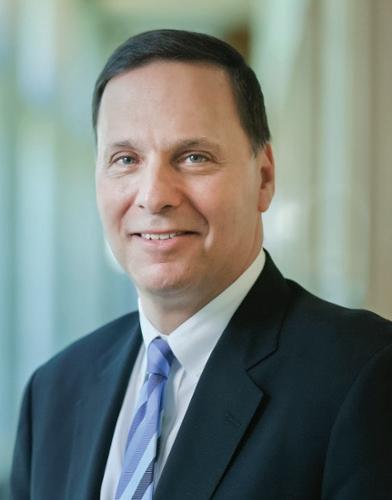
Dear Editor,
My favorite walks I took in college, before I graduated in December, were always the ones at 2 AM or later from the Justice office after production night back to my apartment about a mile away on South Street if I couldn’t land a ride home.
The streets would be really misty and feel surreal and my headphones would be dead because I always forgot to charge them until right before I left in the mornings, but I didn’t mind because the quiet was so peaceful. Except for the times when I’d hear a weird nose and get scared and roll my ankles like 40000 times trying to speed-walk through the night in platform boots. Whatever.
I think the reason that the walks meant so much to me is because they gave me a space to reflect on what I loved about The Justice, even amid exhaustion. In my opinion, there are so many cases in journalism where preconceived ideas of what “objectivity” should look like stop people from truly listening to and hearing what a person has to say.
But working alongside you guys -- a team of 18-22 year-olds who cared SO MUCH about the people around them that they’d spend 14+ hours a week unpaid listening to people and researching and writing and rewriting and rewriting again and pushing themselves to learn and grow and take accountability for the sole reason of wanting their community to be heard fairly -- was invaluable to be around. My hope for the future is that the Brandeis administration takes a note out of your book and starts listening to students to correct systemic issues around housing, food, and the policing of grief — motivated not by money or donors, but by care for our community.
I miss the office, but am also happy to be able to write run-on sentences again without getting them slashed to bits. Also, I still take 2 AM walks, and think of the Justice when I do. But my headphones don’t die on me anymore, because I remember to plug them in before I go to sleep. Maybe that’s what growing up is?
Happy
‘23

I was editor in chief for the Justice during the 2020-2021 school year. It was the pandemic, which was a crazy time to be editor, but that’s not what this letter is about.
For the 75th anniversary edition, Justice alumni were asked to reflect on our time on the paper. Some of my best memories from Brandeis take place in that little office on the second floor of the Shapiro Campus Center, eating chips in my pajamas on production night and trying to balance getting my work done with chatting with my fellow Justice staffers late into the night. That is why it saddens and sickens me to my core to see the university administration’s inhumane response to this most recent escalation of the conflict between Israel and Palestine. Of course, this has been an issue at Brandeis for many years. But I didn’t know that when, at age 17, I chose to attend Brandeis. I and many of my peers felt we were lied to by our school, which touts “truth, even to its innermost parts.”
The truth is that many Black and brown students—especially those who speak out about issues that matter to them—do not feel safe or heard on Brandeis’s campus. The truth is that Brandeis lies to its Jewish students about Israel. The truth is that Brandeis calls the cops on its own students for peacefully advocating for a free Palestine. The truth is that Brandeis uses the concept of social justice as a brand to sell itself to wellmeaning high schoolers who jump at the chance to grow academically in a place where they can supposedly help change the world.
I saw the university’s fraught relationship with social justice with my own eyes while covering protests and advocacy movements for the Justice. I heard about it in interviews with students. I read about it in emails from my own university president, who maintains that Brandeis stands by Israel, even as its leaders and its military carry out a genocide against Palestinians.
I am grateful for my time on the Justice because it gave me a platform to tell the truth when my own university would not. I know this made a difference because now, two years out of college, I still read the Justice to get information about campus happenings—information that University President Ron Liebowitz conveniently leaves out of his pro-genocide email communications. Unfortunately, I have not successfully gotten myself off of that email list.
As a Justice alum, I was proud to read the paper’s coverage of the March vigil in the SCC for the thousands of Gazans killed by Israeli forces. As a Jewish alum, I was proud to read in the Justice that a Jewish student led vigil attendees in reciting the Mourner’s Kaddish that day. It is crucial that people know that not all American Jews support this genocide, and I am pleased to see that the Justice does not shy away from making this known.
I am now a news reporter for a local paper, and I recently covered an event in my town where a local rabbi named Brian Walt spoke against the genocide in Palestine.
“I ask myself, what does it mean even at this time to be a rabbi?” Rabbi Walt said. “What does it mean to affirm Judaism when the Jewish state is engaged in genocide and when its leaders quote sacred texts—our sacred texts, the Torah, the Jewish bible—to justify this horrendous act?”
In the same vein, I ask myself: what does it mean even at this time to be an alum of Brandeis’s student newspaper? What does it mean to reflect on my time on the Justice when members of the Brandeis community I once called home pervert stories of Jewish suffering—our Jewish suffering—to justify this horrendous act?
To current Justice staff who, like me, were tricked into attending Brandeis, do not despair. Your commitment to seeking the truth and reporting it has value, especially in a community where facts and information are stifled in pursuit of a more comfortable narrative. What you do matters. Keep it up.
Gilda Geist Class of 2022
It was just five years ago when Natalia Wiater ’20 (2018-2019 Managing Editor) and I — entering my term as Managing Editor — arrived on the Brandeis campus for the 2019 Brandeis University Alumni Weekend. As the 70th Anniversary of the Justice, we met with many alumni of our newspaper in the Shapiro Campus Center (SCC) office, talking about the history of our beloved publication. We talked about areas of growth the Justice experienced over those 70 years, areas where nothing had changed, and areas where the paper still needed to develop. In many ways, that weekend feels like yesterday, and reflecting on my time at the Justice brings up so many positive memories and much appreciation for how the Justice led me to where I am today.
Amid the challenges of being a Managing Editor are the plethora of phenomenal memories. There are memories of traditions like April Fools editions of the paper that will forever be engrained as core parts of my college experience. Monday night midnight Einstein coffee runs during production were not only a training ground for my future career but also times when we were all so tired that we climbed the stairs of the SCC laughing so hard that we could not stop. All the while, I made friends who are now around the country with whom I continue to keep in touch and FaceTime monthly.
In addition to the memories, my involvement with the Justice could not have prepared me more for my future career. The Justice instilled a passion for writing and ethics, which I have carried with me in medical school and will continue to use as I proceed into general surgery residency this summer. There is something extraordinary about considering the areas of journalism that were not easy “black or white” decisions. That grey area much informed my decisions as a Managing Editor when choices were not always easy. Many people ask me how my experience in journalism applies to medicine. The ability to navigate changing situations and work as a team to achieve a common goal could not be more applicable.
All of this said, one thing is absolutely for certain: I will never forget to “Seek the truth and report it, minimize harm, act independently, and be accountable.”
Jen Geller ‘20 Managing Editor 2019-2020■ Exposing the true mental strengths of Brandeis men's tennis and their path to redemption for the rest of their season.
By REBECCA SUAREZ JUSTICE STAFF WRITEROn Saturday, March 9, at the Red Auerbach Arena in Waltham, Mass., the Brandeis University men’s tennis team showcased their talents by winning their first dual match of the season against the Franklin Pierce University Ravens. The Judges won their first seven matches, with a doubles sweep and singles players in positions one through four prevailing over the Ravens.
At singles positions five and six, the Ravens won both matches in a three-set match, despite being down a set for each match. Consequently, the final score of the dual match was 7-2. Each court echoed with the sound of squeaking tennis sneakers and uplifting cheers from the teammates, coaches and the crowds for the Judges and the Ravens.
In their first five matches of the season, the Judges were faced with difficult matches and ultimately defeat from a Division I team, Bryant University, and nationally ranked Division III teams, such as #5 Claremont-Mudd-Scripps, #30 University of Redlands, #18 Caltech College and #2 Middlebury College. Although they faced the first month of their season with nothing but defeat as a team, the Judges used this as motivation to keep going.
Several successes caused specific Brandeis players to stand out on both the doubles and singles courts. More specifically, Pierce Garbett ’27 and 2023 All-UAA honorable mention, Alex Merson ’26 acknowledged their personal successes within each of their matches and how important the team culture is on and off the court. At position number two for doubles, Merson and his partner Aaron Bayse ’24 overcame the Ravens with a final score of 8-3. In addition to his doubles match, Merson dropped only four games from his singles match at position number two, with a final score of 6-1, 6-3, clinching the victory for the Judges.
At position number one for doubles, Garbett and his partner Dylan Walters ’24 swiftly defeated the Ravens with a final score of 8-0. This dual match for Garbett was extremely different from the previous matches he had played for the Judges, as this was the first time he played position number four in singles. Although Garbett described his singles match as,“difficult to maintain focus on my match with all
the things going on around me with matches and cheering,” his can-do attitude shined on the singles court, especially considering the emotional support system he has to back him up. He describes the team energy as “hearing other people doing well makes me also want to do well.” Garbett’s win in singles was the last point of the day in favor of the Judges.
The closest matches of the day in singles and doubles came from Harrison Haui ’27, where he made his dual-match debut for the Judges. In doubles, he defeated the Ravens at position number three with his partner, Huasen Dong ’27, with a final score of 8-7(1). In singles, Haui started out strong at position number six, winning the first set 6-3 in 48 minutes.
However, Ravens player Orlando Guerrero ’26 got consistent and loud encouragement from his teammates, swinging the momentum back into his favor, winning the second set 6-3 in 52 minutes. With one set for the Judges and one set for the Ravens, the energy on court six was amplified, from the respective coaches, teammates, and crowd. Guerrero ended up on top, defeating Haui in the third set tiebreak, with a final score of 10-6, claiming the second point for the Ravens. Although both matches did not favor Haui, he commented on his determination to do better for the rest of the season, stating “I can feel the excitement in the team as we welcome our first hard-fought victory. It’s a great point to build off of into the remainder of this season.”
Brandeis men’s tennis tennis will host and compete against Skidmore College on Saturday, March 23 in Saratoga, New York.

■ The offseason is a time of lots of activity and bustle in the National Football League as fans and players eagerly await the new roster of their favorite team.
By PRATEEK KANMADIKAR JUSTICE STAFF WRITERThe National Football League landscape is experiencing a dramatic upheaval as the curtain came down on another exciting season. Teams are adjusting their rosters and planning for the next season with the flurry of deals and retirements. The bombshell deal of star running back Derrick Henry going to the Baltimore Ravens, which sent shockwaves through the football world, is one of several headlines that are dominating the offseason buzz.
Derrick Henry was acquired from the Tennessee Titans by the Baltimore Ravens, who have always been strong challengers in the AFC North — a risky move. With his brutal running style and unmatched agility, Henry is a powerful force in the NFL. He joins a Ravens offensive that already has explosive playmakers like Marquise Brown and Lamar Jackson. The action indicates the Ravens' intention to strengthen their ground game and give their potent offense a new facet.
Henry's departure from the Titans signifies the end of an era for them. The talented running back has been a vital component of the Titans' attack, displaying perseverance and toughness on the field as seen by his over 2,000 rushing yards in the 2022 campaign. There is a hole in Tennessee's backfield caused by Henry's departure, and the Titans have not yet revealed how they intend to fill it.
The NFL landscape has changed due to a number of noteworthy deals that have occurred in addition to Henry's departure to Baltimore. By signing All-Pro cornerback Jalen Ramsey from the Los Angeles Rams, the Kansas City Chiefs created a stir and added one of the best defensive players in the league to their secondary roster. With Ramsey's arrival, the Chiefs’ defense gains another dynamic player as it looks to improve in the upcoming season and defend their championship.
The carousel of quarterbacks kept turning as multiple clubs made big adjustments behind the iron. After a dismal season, Pittsburgh Steelers fans now have optimism for a comeback thanks to the team receiving star quarterback Justin Fields from the Chicago Bears. In the meantime, experi-
Center Aedan Using ’24 was selected as the 2024 University Athletic Association Men’s Basketball Defensive Player of the Year. He averaged 1.2 blocks per game and 1.2 steals per game, ranking seventh and eighth in the entire conference, respectively, alongside 6.2 rebounds per game, which ranks eleventh.
Using, whose favorite National Basketball Association player is Dirk Nowitzki, put up a season befitting the skilled German big man, as he led the Judges in steals, blocks, rebounds and assists per game while also notching 5.8 points per game and playing in all 25 contests. Using becomes the first member of the men’s basketball team to lead the Judges in four or more statistical categories in over a decade.
“Aedan had overcome a lot of adversity to get to where he was this season,” head coach Jean Bain told Brandeis Athletics. “He worked extremely hard, first to come back from his injury, and then on and off the court, not just on his own game, but with other guys to help them get better. I'm really happy for him.”
Using’s defensive player of the year campaign was a triumphant return after missing the entirety of the 2022-2023 season.
“I came into this season coming off a serious knee injury that required two knee surgeries and took me out for about 16 months from basketball,” Using told The Justice. “There were times where I wasn’t sure if I’d ever be able to play again.”
Determined to make every game count, Using was a versatile and efficient contributor in many of the Judges’ contests. Whether it was scoring 15 points in a 20-point comeback win at Rochester University or 7 assists, 2 blocks, and 4 steals against Carnegie-Mellon University, his all-around game propelled the men’s team to wins and Using to UAA recognition.
“It’s an award he definitely deserved,” Bain reinforced.
The men’s team had the fewest points allowed per game in their conference, 65.8, alongside leading the UAA in turnovers forced per game
at 14.7. The statistic of 65.8 points allowed per game ranked 34th in Division III Men’s College Basketball.
“I won defensive player of the year but I was just a piece of one of the better defensive teams in the country,” said Using. “The coaches put together excellent game plans each and every game and as a team we did a great job of executing and focusing on that end of the court.”
Playmaking complemented Using’s defensive success. He averaged 2.8 assists per game, seventh best in the conference. His 2.09 assist to turnover ratio, a mark of how efficiently a player records assists, led the team and was the highest recorded for the Judges since 2016. It also ranks third in the conference and 61st among Division III men’s basketball players; he is the only Center to rank in the top 100 for assist to turnover ratio.
“I went into each and every game as if it were my last because I know now that I am never going to take playing basketball for granted again,” Using said in a summary of his approach to this season. The Judges went 14-11 for the season and 5-9 in conference play in 2023-2024, Using’s final year, improving from their 12-13 record last year.

enced signal-caller Jimmy Garoppolo of the San Francisco 49ers startled the football world by leaving the Bay Area, making room for rookie sensation Trevor Lawrence to assume the starting job.
Teams vying to choose the next wave of superstars made for an exciting and dramatic NFL Draft. By selecting quarterback prospect Malik Willis with the first overall pick, the Detroit Lions ignited controversy and heralded a new chapter in the long-suffering franchise's history. The Green Bay Packers, meanwhile, created a stir when they traded up to choose outstanding wide receiver prospect Chris Olave, providing standout quarterback Jordan Love with an additional tool.
One thing is certain as the NFL offseason goes on: 2024 is going to be one of the most thrilling and unpredictable seasons in recent memory. Fans everywhere are excitedly awaiting the start of another exciting NFL season — one marked by prominent players switching teams, coaching changes and the influx of new talent.

TRADED:
■ The first issue of The Justice with a sports section came out in 1949, but what has the legacy of sports at The Justice looked like over the last 75 years?
By RANI BALAKRISHNA and MARINA ROSENTHAL JUSTICE EDITORSThe Justice published its first issue in March 1949, a six-page spread telling the stories of the very first year at Brandeis. Page five held a column created by Sports editor at the time, Lou Lindauer.
‘The Press Box," a column with news on Brandeis and worldwide sports, had a description reading “This is it, guys and gals, your sports column. With our Staff of sports experts (?) and armchair quarterbacks, we will try to bring to you in condensed form the most important news in the sports World, and in the athletic activities of Brandeis.” Capturing the humorous essence of the Brandeis student right off the bat, the headlines ignite a passion for sports amongst readers for decades to come.
At the start of the school year, Brandeis did not offer any organized sports, but according to the article, two groups formed football teams: the Irky’s Jerkies led by Captain Irky and the Baron’s Babies. The Jerkies prevailed over the Babies with a score of 21 to 6.
Following the jolts of the vigorous football season came the first snow, and therefore, pent up energy on the part of these athletes. As a result, the Brandeis athletes took up boxing, wrestling and even water pistol duels. Unfortunately, these sports did not receive the same raging attention as their respective counterparts, leaving the athletes dry and the university infrastructure wet.
Basketball season was to follow, as the teams utilized the Waltham gym and donated equipment. The talent of Ivan “The Prophet” Seder and Al Greenwald did not go unnoticed, their skills highlighting a bright future to come. The hopeful athletes prayed for a coach in their near futures, longing to “flex their muscles and show [their] ability on the field of competition.”
The issue even boasts the introduction of a newer sport to their game rotation, ping-pong. In their spare moments, these athletes partook
in intense matches, said to result in some teamon-team upsets. The sports staff predicted the future of Brandeis athletics’ coverage in the student newspaper, hoping for the introduction of softball, handball, swimming and volleyball. With high hopes for what lay ahead, they called upon the creation of a new softball diamond and courts amongst the buildings we still know and love. Fortunately, we’ve come a long way from The Justice's 1949 first sports column. Our sports section now proudly features a fivepage spread, highlighting 19 varsity teams and the sheer talent and discipline of our Brandeis athletes. While staying true to the visions of our predecessors, Brandeis sports coverage has flourished in ways previously unimaginable. As said best by the original sports staff, “You’ll always win if you’re a good sport.”


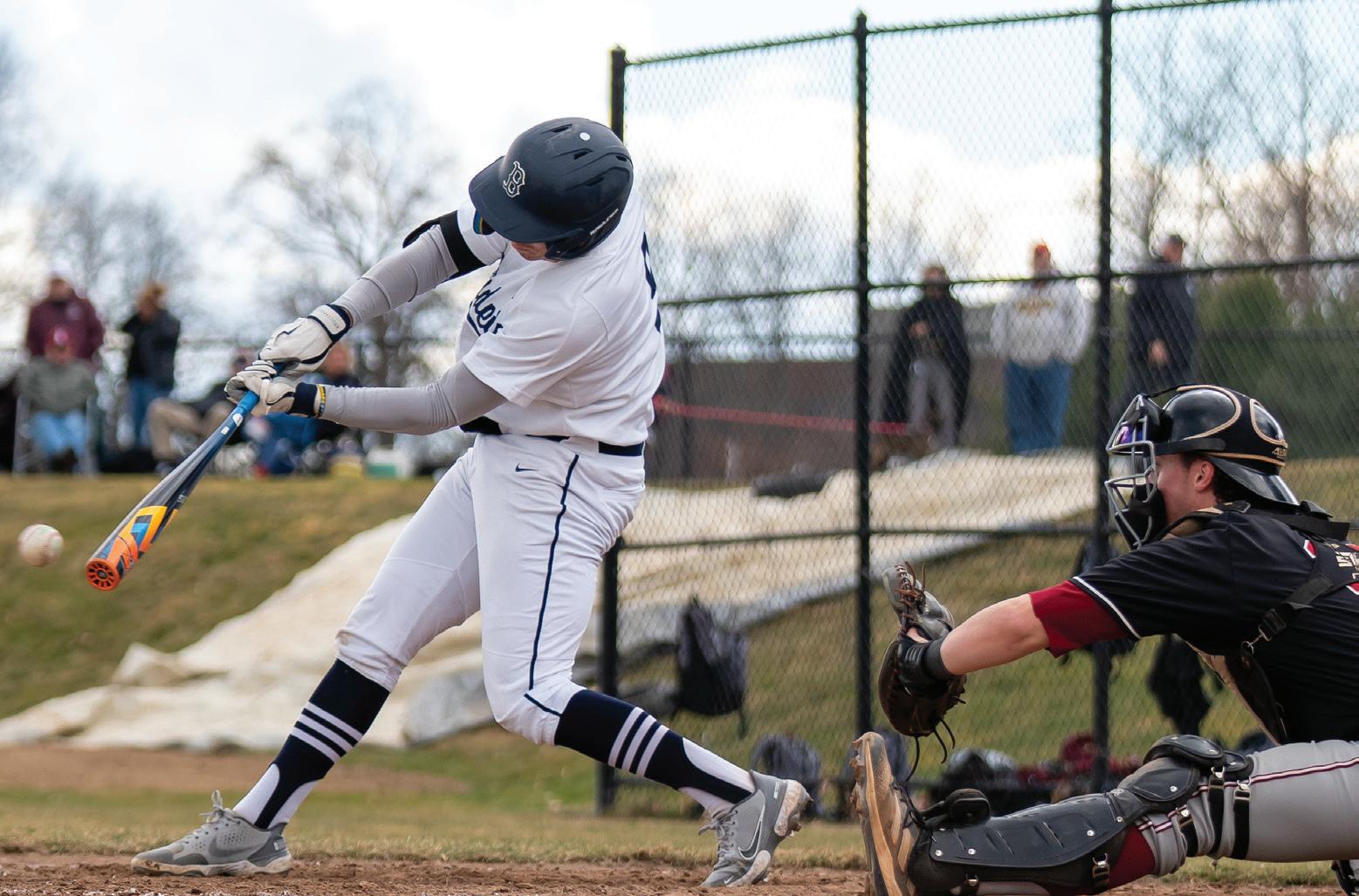

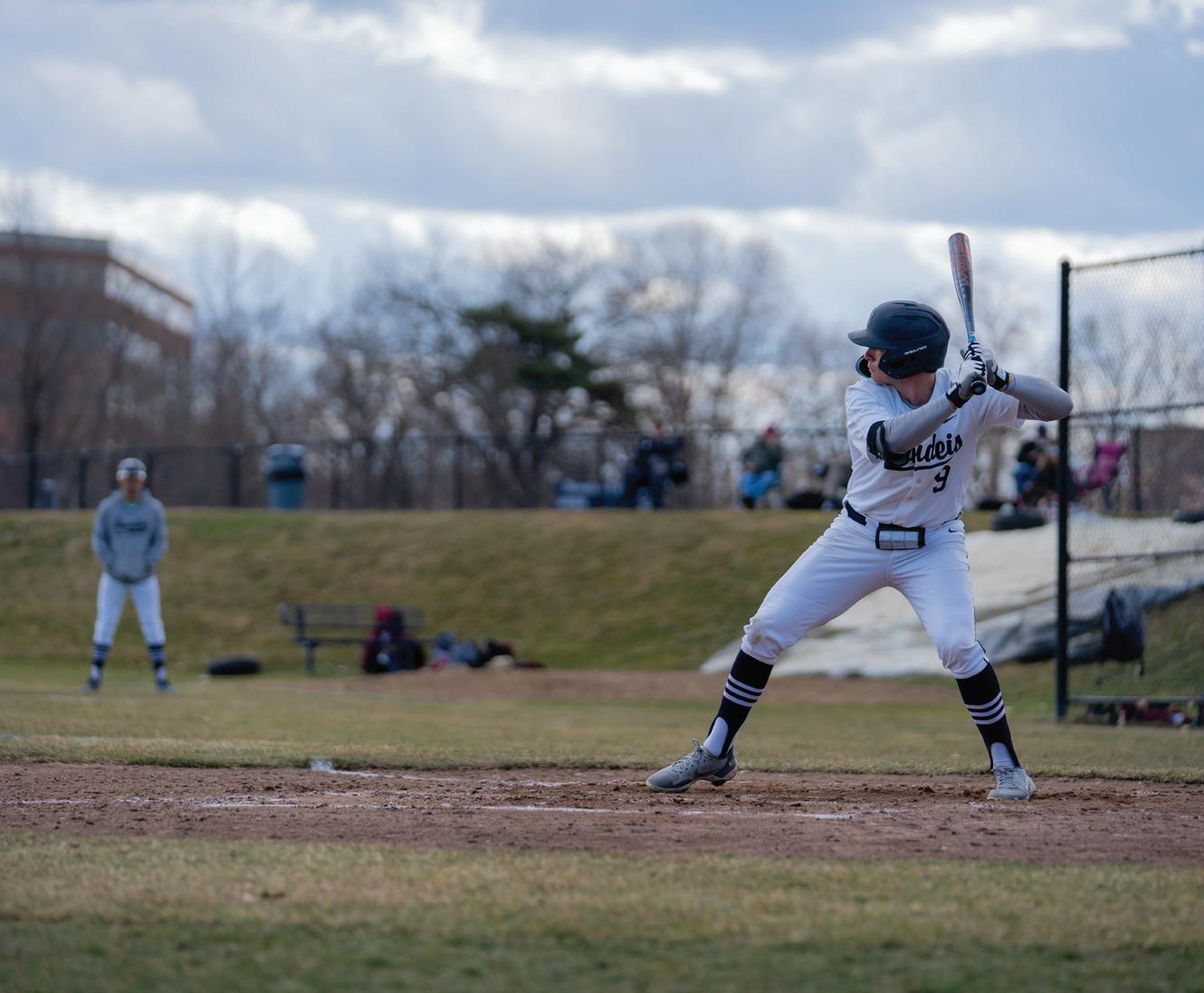
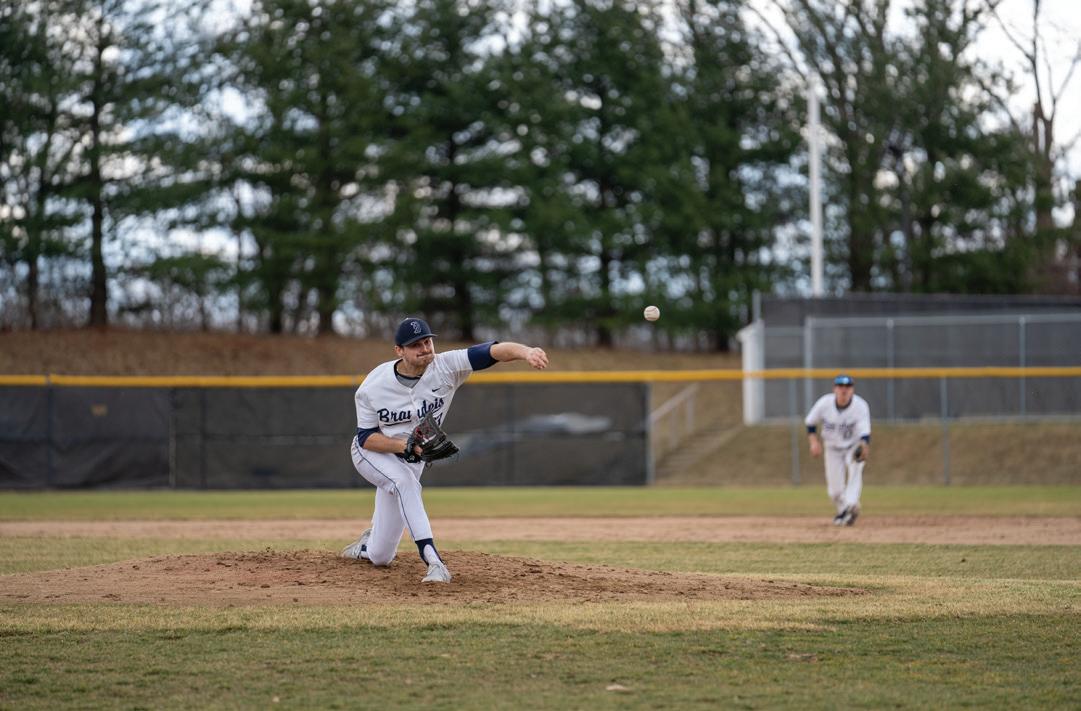
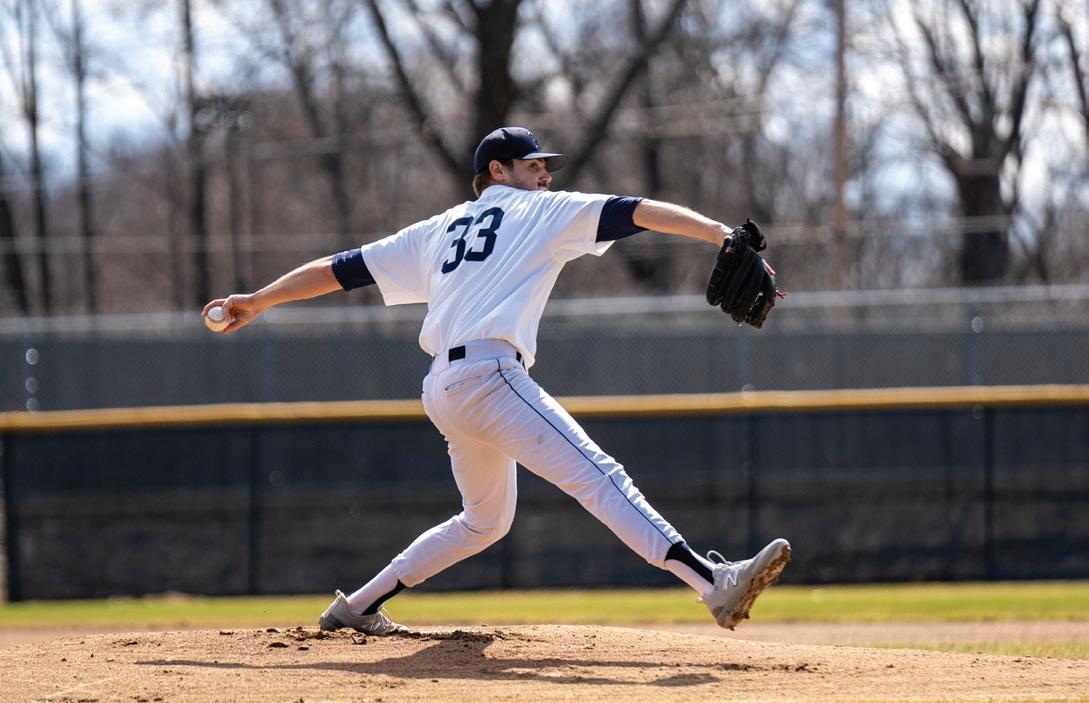
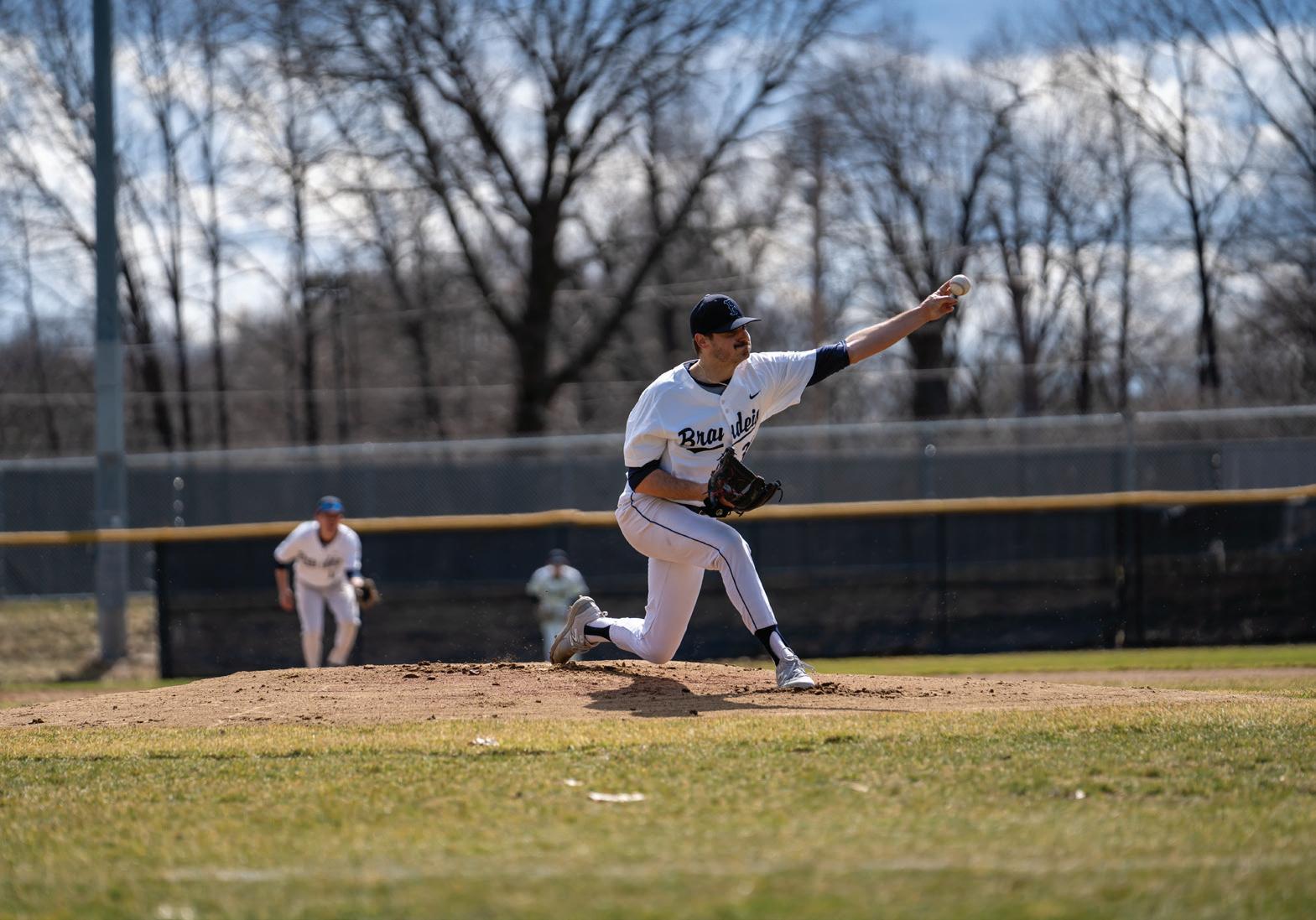
UPCOMING GAMES:
Saturday
Sunday

Marc Maestri M’24 lead the team with 17.4 innings pitched.

Total RBIs Total Innings Pitched
STANDOUTS
Singles
Dylan Walters '24
Doubles
Dylan Walters '24 and Tommy Harrison '26
STANDOUTS
Singles
■ A review of past winners of the highly anticipated collegiate basketball tournaments and the prospective men’s and women’s teams this year.
By EZEKIEL BLOOM JUSTICE STAFF WRITERIt’s that time of the year again. For some, it’s just another month. Maybe you’ll go on a nice vacation for spring break. However, for the college basketball superfan, it’s finally time for March Madness. March Madness, the nickname for the widely televised men’s and women’s NCAA Division 1 Basketball Tournaments, is a spectacle filled with levels of intrigue and suspense unrivaled in the sports world. Every NCAA Division 1 conference tournament winner receives an automatic bid for entry, meaning that underdog squads are pitted against the juggernauts and titans of college basketball. Some notable upsets include #16 seed Fairleigh Dickinson’s shocking dismantling of #1 seed Purdue in the 2023 men’s tournament, and #16 Harvard triumphing over #1 Stanford in the 1998 women’s tournament. Stunning wins against the college basketball blue-bloods during this upcoming tournament may add to this list of improbable victories, but in most cases, the championship comes down to a battle of college basketball behemoths. As a result, here are a few of the favorites to watch for in the men’s and women’s March Madness tournaments.
However, a team not currently ranked #1 is looking to accomplish something not seen in men’s college basketball in almost two decades. Not since the Florida Gators in 2006 and 2007 has a team won back-toback NCAA championships. #2 University of Connecticut reigned victorious last year with a convincing victory over San Diego State, poised to do so again this year, and with a core consisting of guard Tristen Newton, sharpshooter Cam Spencer, and shot-blocking big man Donovan Clingan. Look for star first-year player Stephon Castle to have a major impact this tournament as well.
Another team that has been largely unstoppable as a pillar of regular season consistency are the Purdue Boilermakers. However, their questionable postseason resume brings up many questions about how successful they will be during college basketball’s most important month. In addition to their aforementioned loss to Fairleigh Dickinson, they succumbed to #15 seed Saint Peter’s in 2022, and fell short against #13 seed North Texas the year prior, in 2021. Nevertheless, their prospects may look brighter this year. They are again manned in the middle by the most dominant player in college basketball—the towering 7’4 center Zach Edey. With point guard Braden Smith elevating his shooting and playmaking this year, and the high impact transfer Lance Jones from Southern Illinois, Purdue might finally kick their habit of falling to higher numbered seeds in 2024.
umph over South Carolina in March, any team with Clark has a fighting chance to make history.
Speaking of South Carolina, they are the overwhelming favorites in the women’s tournament this year, with coach Dawn Staley again heading a program that has challenged the status quo of traditional powers, such as UConn, having almost guaranteed postseason success. The Gamecocks were champions in 2022, and are currently undefeated going into March Madness, putting them in a prime position to repeat their aim of reigning supreme in the college basketball world. Center Kamilla Cardoso and shifty first year guard MiLaysia Fulwiley are central figures on this talent filled team.
A couple of other intriguing squads in the women’s tournament include Louisiana State University and University of Southern California. LSU, the defending champs, is led by Angel Reese, who many have proclaimed as a major rival to Clark, due to the two matching up in the championship game last year. USC is powered by first year phenom JuJu Watkins, who is averaging 27 points per game on a team currently ranked #3 in the country. We will simply have to watch to determine if these challengers can dismantle Clark and the seemingly unstoppable South Carolina Gamecocks.
Hopefully this rundown provided both an insight into the tournament and an exciting preview for the weeks of entertaining basketball to come. No matter what team you support, March Madness is bound to be a highlightfilled affair, with upsets galore and buzzer-beaters that shock and awe. Enjoy the madness, it’s March!
At the moment, the widely acknowledged favorite in the men’s tournament is the Houston Cougars. Coach Kelvin Sampson has led the squad to a dominant regular season, finishing with an authoritative 28-3 record. Senior AllAmerican guard Jamal Shead heads a stifling top-ranked Houston defense that has propelled a great deal of their success. Even though they recently moved from the American Athletic Conference to the notoriously competitive Big 12 Conference, this switch has not deterred them in the slightest. The Cougars are geared up for a deep run in March.
Lika Bolkvadze '27 and Bhakti Parwani '25 leads the team with a record of 4-3.
Doubles
Bhakti Parwani '25 and Rebecca Suarez '26 lead the team with a record of 9-2.

MEN'S UPCOMING MATCHES:
Saturday at Skidmore College
WOMEN'S UPCOMING MATCHES:
at Wesleyan University
Results from the NCAA Regional Championships on Mar. 10
UPCOMING MEETS:

NCAA Championships at Ohio State on March 21 - 24
Results from the NCAA Indoor Championship at Virginia Beach, VA on Mar. 8.
MEN'S
800 Meters
TJ Carleo '26 came in 18th place, last in his heat, with a time of 1:54.33.
UPCOMING MEETS:
The indoor season has concluded. The outdoor season will commence on March 30 at the Tufts Snowflake Classic.
On the other hand, the largest storyline of the women’s tournament is not necessarily its most dominant team, but rather its most entertaining player. Iowa University guard Caitlin Clark has been on an otherworldly tear this year for the #2 Hawkeyes, averaging an absurd 31.9 points, 7.3 rebounds, and 8.9 assists per game (her points and assists lead the nation). Most notably, she broke Pistol Pete Maravich’s all time NCAA scoring record (men’s and women’s) with an astonishing 3,668 career points. Clark shoots 30 foot jumpers with ease, finds her teammates for easy scores, and electrifies the crowd with her engaging style of play. Although the Hawkeyes are not expected to tri-
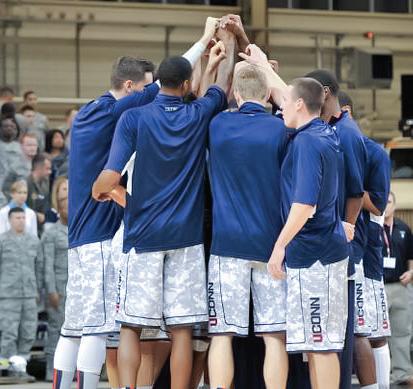
The Brandeis Fencing Teams had a very successful Sunday last week at the NCAA Northeast Regional Championships that took place at Long Island University. Three members of the sabre squad have been awarded the honor of being able to compete at the NCAA National Fencing Championships. The NCAA National Collegiate Championships will take place in 2024 at Ohio State University in Columbus, Ohio. This event will begin on March 21 and conclude on March 24. The women’s competition will take place over the first two days while the men’s competition will take place over
the second two. Brandeis will be represented by one female fencer and two male fencers. For the third time in her collegiate athletic career, the women’s representative in this competition is graduate student Maggie Shealy M’25. She finished third at the regional competition, allowing her to be ranked second as she advanced to the nationals. The men’s representatives are Tony Escueta ’25 and Lev BenAvram ’26, who gained the opportunity to advance to the NCAA national fencing championship for their third and second years respectively. Escueta received the Bronze medal at the regional
championships, beating BenAvram by one seat. Escueta placed seventh and BenAvram placed eighth.
BenAvram will not compete at the NCAA championships this year, even following his recognition as National Collegiate Sabre Newcomer of the Year last year. He has instead decided to compete at the International World Cup event in Hungary. He is currently ranked eighth in the country and needs to advance to the top four in order to qualify for the 2024 Olympics as a member of the U.S. Men’s National Team.
-Anna Martin"Jury Duty" is a weekly column that spotlights different athletes. Please email sports@ thejustice.org if you would like to nominate a Brandeis athlete. We hope to bridge the
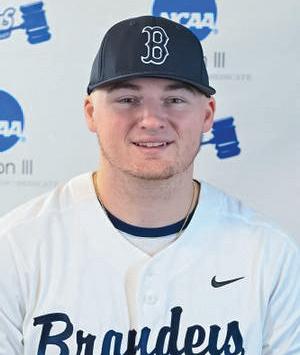

Eddie Zanor M’25 is a member of the Brandeis Baseball team, and recently had a standout week as the Judges competed against several different teams. In the team’s first win of the season against Trinity College, Zanor went two for four at the plate, putting up a team-high of four runs batted in. The first baseman also drove in two runs with a single in Brandeis’ defeat against Tufts University. Not only has Zanor’s bat been hot offensively, but the transfer graduate student has played key defense in the Judges’ sweep of the Massachusetts Maritime Academy. Zanor came to the mound from first base in the bottom of the sixth inning in the second game
and only allowed two runs over three innings. Against Eastern Nazarene College, Zanor almost hit for a cycle, meaning he almost hit a single, double, triple and a homerun all in one game. He tallied all of these hits except for a triple, going four for five with two runs batted in. Zanor has truly stayed hot offensively, and hit his third home run of his career on Sunday, March 17. While not on the field, Zanor enjoys listening to artists such as Drake, Dua Lipa and Luke Combs. He enjoys hanging out at the Gosman Sports and Convocation Center and having cookie dough ice cream when the weather gets warmer. Head on down to Stein Diamond to cheer on Zanor and the rest of the Brandeis baseball team!
Page 16
Baseball took on the Massachusetts Institute of Technology Beavers on Thursday, March 14 at home on the Stein Diamond, p. 14.
Tuesday, March 19, 2024

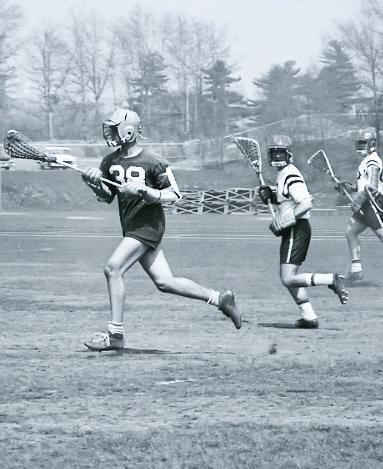
Waltham, Mass.
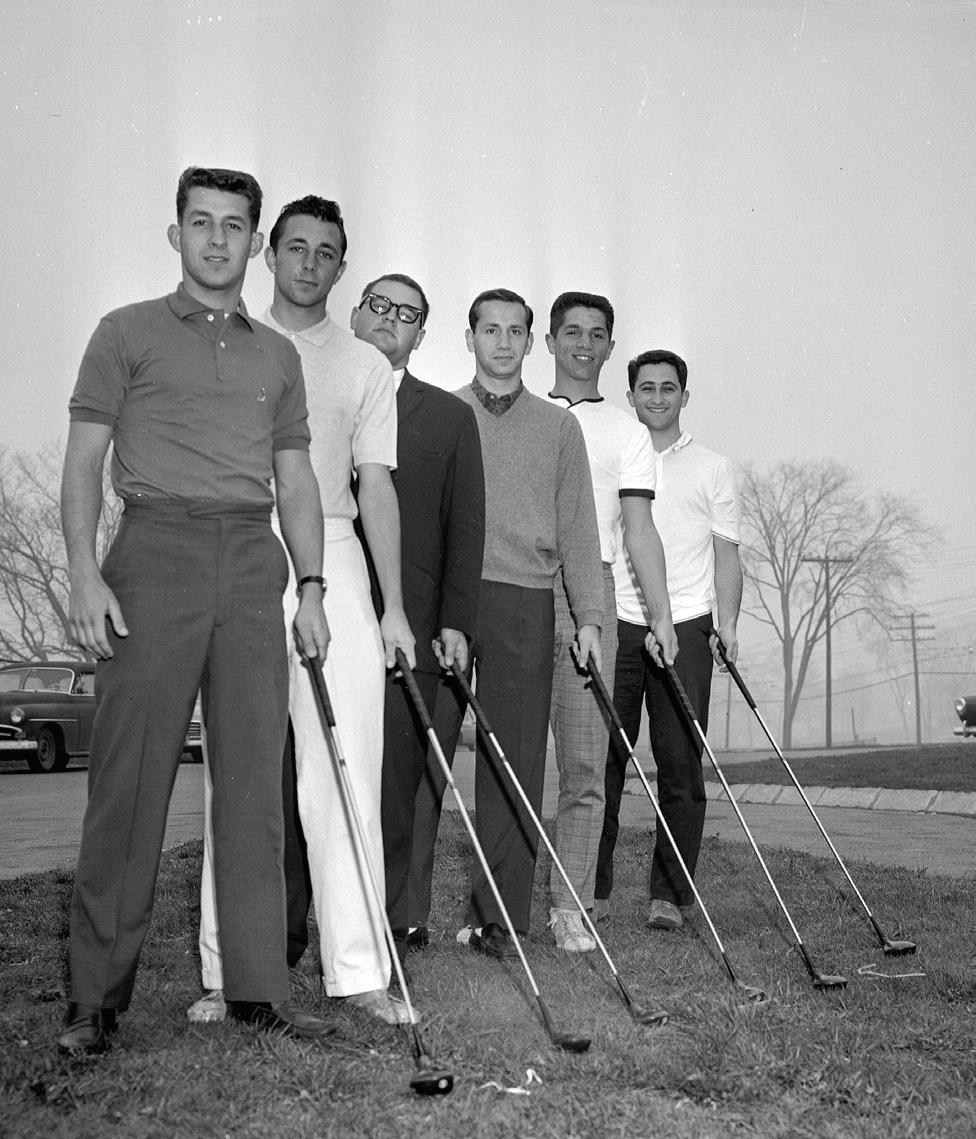
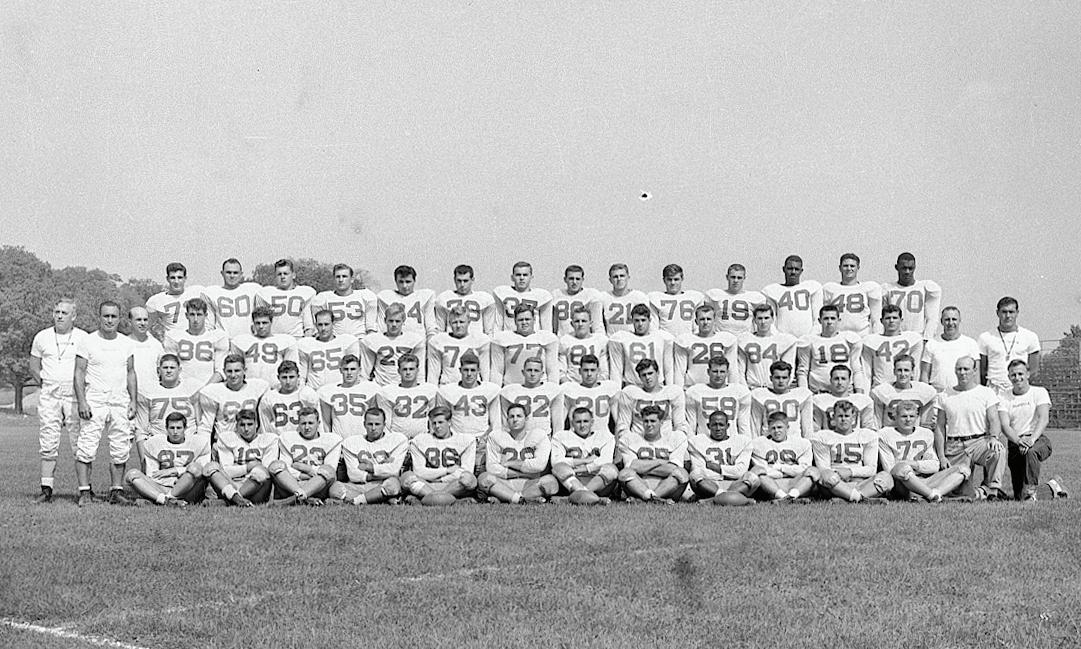
■ During Brandeis University’s 75 year history, several varsity sports have been discontinued, including football, golf, sailing, wrestling and lacrosse.
By ELIZA BIER JUSTICE DEPUTY EDITOROver Brandeis University’s 75 years of existence, many sports have come and gone. While club and intramural sports appear and disappear in accordance with student interest, there are also varsity sports that have either been discontinued from Brandeis Athletics or have been relegated to club or intramural status. These sports include football, lacrosse, golf, and sailing.
The Brandeis football team existed for nine seasons, from 1951-1959. The team had one very successful season, and a highlight was a game against the University of Bridgeport at which the Brandeis Judges won 33-10. Despite their successes and producing alumni that went on to have professional football careers in the AFL and NFL, the Brandeis football team ceased to exist following 1959. When asked in a March 15 interview with The Justice why the football team was discontinued, Sports Information Director Adam Levin ’94, MS ’21 responded by explaining that the original purpose of the football program was to build the student body but as “the University’s standards and
reputation rose; it wasn't necessary to build the student body through athletics, through football specifically. They felt they weren't bringing in the caliber of students they wanted to and felt that the program had kind of run its course I guess,” citing Abram Sachar’s book "A Host at Last."
Although Brandeis’ football team did not exist for long there are a few notable alumni of the program including Mike Long ’60, a two-time inductee into the Brandeis Athletics Hall of Fame. Graduating from Brandeis class of 1960, Long played for the Boston Patriots’ inaugural season as their first number 87. In 1970 the Boston Patriots joined the NFL during the AFL/NFL merger and changed their name to the ‘New England Patriots.’ Long was cut halfway through his season with the Boston Patriots and went on to sign with the New York Titans before joining the Marines.
Another notable Brandeis Football alum is Bill McKenna ’55. McKenna was Brandeis University’s first All-American in any sport. During his Brandeis football career, the team was successful with several multi-touchdown games. In an Oct. 23, 2012 interview with BrandeisNOW, following Mckenna’s death, former teammate and fellow Brandeis Athletics Hall of Fame inductee, Richard Bergel ’57 commented that McKenna’s “decision to play at Brandeis and for [coach] Benny Friedman helped put the school on the map.”
During McKenna’s professional football career, the Philly Eagles chose him in the 1955 NFL draft in the seventh round. He went on to play in the Canadian Football League
instead. From 1955-63, McKenna played six seasons with the Calgary Stampeders. During his time playing in the Canadian Football League, McKenna set league records including a 104-yard reception in 1955, on a pass from Don Klosterman. Mckenna is one of Brandeis’ most notable athletic alumni. While football ended due to a matter of campus prestige, some varsity sports were discontinued due to financial reasons. America was dramatically affected following the 2008 financial crisis. Brandeis University was especially hit hard during this time as many of its prominent donors fell prey to the Bernie Madoff Ponzi Scheme. The most notable of these donors was the Carl and Ruth Shapiro Family Foundation, which lost $145 million — over half of its total assets. Following this hit to Brandeis donors, many university departments, including athletics, were asked to make budget cuts. The cuts made by athletics included the Brandeis varsity golf team and the Brandeis varsity sailing team.
Beginning in the early 60s and ending following their 2009-10 season, the Brandeis varsity golf team existed for almost 50 years. Following the Bernie Madoff Ponzi Scheme in 2008, Brandeis Athletics tried to eliminate the golf team but at first were unsuccessful. The golf team prolonged their discontinuance through passionate and avid fundraising efforts. Through these fundraising efforts, the golf team was able to exist for one more season before being discontinued after the conclusion of their 2009-10 season.
Notable alumni from the Brandeis golf program include Jason Sobel ’05 and Arron
Katzman ’05. Sobel is an award-winning senior golf writer at ESPN and has worked at the company in many other capacities.
Katzman is a two-time Emmy Award-winning producer on ESPN’s “College GameDay”.
Similar to golf, Brandeis University’s varsity sailing team was discontinued following departmental budget cuts. The sailing team was established around the same time as the golf team and was discontinued after their 2008-09 season. The sailing team now exists as a club sport and competes in the New England Intercollegiate Sailing Association. As relayed by Levin, both the varsity golf and sailing teams were cut over other sports as they were performing less successfully.
At one point, Brandeis University also was home to a men's varsity lacrosse team as well as varsity wrestling. The Brandeis lacrosse team existed from the late 60s to the early 80s. In a transcript of “Those Were the Days: A look Back at Early Brandeis Athletics,” Levin noted that “lacrosse and wrestling ended because of just a lack of interest and [inability] to maintain rosters that were able to be competitive.” These sports still exist as clubs. Just last semester, in the fall of 2023, the Brandeis Lacrosse Club was founded by Lauren Swartz ’26 and was chartered shortly after.
Currently, Brandeis Athletics is home to 19 intercollegiate varsity sports that compete in Division 3 of the NCAA.
Editor's note: Justice Editor Elizabeth Liu ’26 is a member of the Brandeis Lacrosse Club and did not contribute to this article.
Photos courtesy of THE ROBERT D. FARBER UNIVERSITY ARCHIVES & SPECIAL COLLECTIONS DEPARTMENT PIONEERS: From top left to right: the women's lacrosse team in May 1956, the men's golf team in May 1961, the men's lacrosse team in 1965 and the men's football team in 1952.
How do we represent our suffering? Is it individual, communal, ritual or ancestral? Noé Martínez aims to tackle these feelings through the exhibition “The Body Remembers.” This exhibition opened on March 13 at the Rose Art Museum.
Martínez, an Indigenous Mexican artist of Huastec heritage, uses his art to communicate the pain, the traumas and the present state of his people in Mexico. Representing his people through a colonial lens, the exhibition forces a silence in the room. His work takes inspiration from multiple different styles and mediums, reaching into poetry and film to create a truly unique space. These works force an uncomforting interaction between audience and artwork. Breaking from the traditional gallery installation, this monumental and somewhat architectural exhibition is thought-provoking and inspiring.
On display at the Rose Art Museum, the exhibition has three multimedia installations in a truly awe-inspiring curation. It is first necessary to walk around the main wall, where there is a cutout that frames the exhibition, giving a glimpse of the work. This frame seems to separate the viewer from the art, positioning us as bystanders to the suffering of the Huastec community. Feeling separated in this way makes the viewer somewhat complicit, a voyeur to the colonial past. But experiencing this exhibition forces us to acknowledge the continual pain of colonization throughout history.
Entering into the main gallery, the first thing you notice is an obstruction. A barrier of 12 white ceramic figurines, pots and sculptures encircle and confront the viewer. The figures show the cardinal directions and are aligned with them in exhibition, a call to Martínez’s ancestral religion. These anthropomorphized ceramics seem to hold or possess a presence in the room. At the center of the compass is a hanging mass of ceramic figurines and rope with the faces peeking through painted a terracotta red. Strangled and surrounded, the presence they hold is intense, inspiring and harrowing. Each figure, in a serene harmonious stillness, attacks the very existence of the viewer on the Earth where they stand. This piece is called “My body is a cemetery and my path is a memorial.” Martínez asks the viewer to consider the idea that his heritage, his own flesh, is a past filled with death and honor. A cemetery is not a place
This past Wednesday, March 13, an exciting new post-baccalaureate art exhibition opened in the Dreitzer Gallery. Titled “Visceral Reflections,” the exhibit features four artists and a variety of art mediums. The four featured artists are Brianna Howard, Kelly Mangan, Pavol Roskovensky and Noelle Ventura. Each artist explored different themes, often drawing on their own backgrounds to help influence their work. At both entrances to the gallery there is a table with a black binder on it which contains information on each artist, the themes within their work, and their artistic process.
When entering the gallery, Noelle Ventura’s sculpture work is the first thing on display. The work is made out of vinyl fabric, tape and ceramic. The sculpture “Occupancy” is installed in multiple parts along the walls and a centerpiece rises out of the floor. The black vinyl fabric twists, turns, folds in on itself and juts out of the wall toward the viewer. The stark whiteness of the wall further contrasts with the sculpture. Fixed among the sculptures on the wall are small ceramics. These bright ceramics are meant to “engage in dialogue with [the] soft sculpture, examining the density of objects and the impact of gravity.”
Kelly Mangan’s work centers on childhood and memory which she portrays through a series of paintings and one ceramic work. The paintings have a deep and dark color scheme and the memories depicted within them loom through a shadowy past. Mangan said the paintings “depict an upbringing of unabashed joy, acute moments of anger, and intense fears, all told from my adult perspective and colored by knowledge and trauma accumu -
of forgotten people. Martínez himself is memorializing them, remembering his ancestors, their place in his path, and in his future. The figures form their own path as well, guiding the troves of ambulating viewers. Our craning necks stretch upwards, a sea of chins point to the sky in awe of the walls of portraits lining frames.
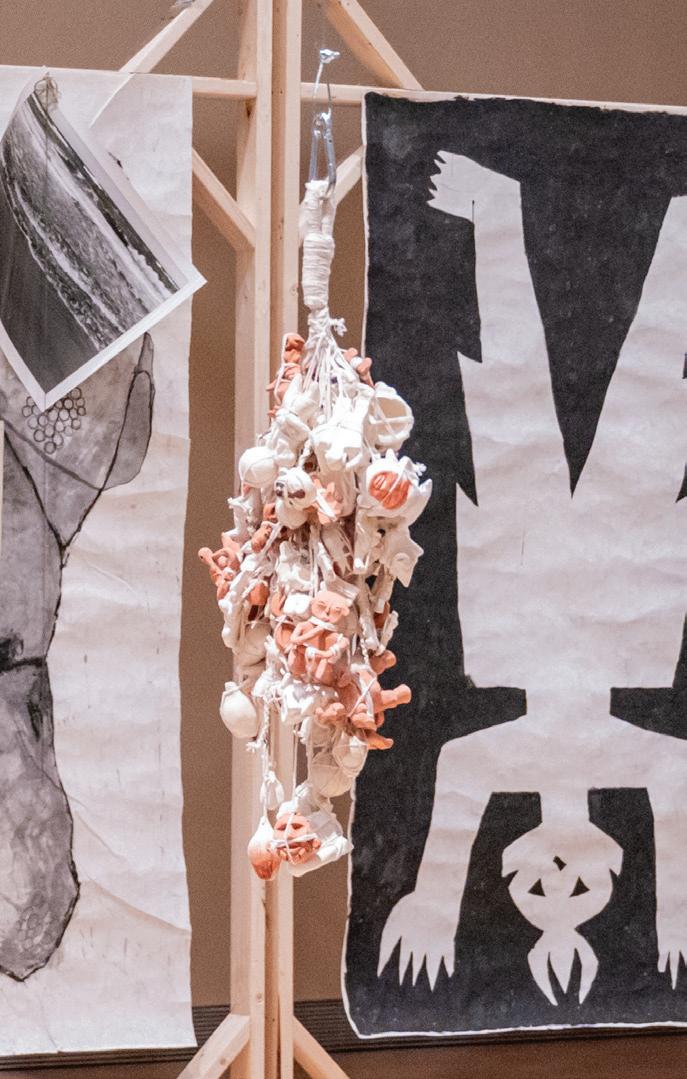
ARTWORK:
Creating dimly lit hallways and passages, wooden frames and portraits stand monumentally in the back of the exhibition. The walls of portraits are a part of “The Motherland of images,” an installation of collaged works detailing the slave trade of not just the Huastec people, but African people as well. These life size collages take time and space to appreciate. In many different styles of representation, bodies and body parts are drawn on paper. Photographs of ships, newspapers and advertisements are attached by chains throughout the installation. History weighs heavy as you are suddenly forced, by the ceramic installation, to be face to face with a bound body. Towering over the viewer is another wall of portraits, reaching astronomical heights. The magnitude of these works feels like an
overwhelming shadow, pressing hard on the shoulders of the audience. Martínez’s work encapsulates the colonial trade and horrors of history in this series. As you move through the portraits, words on the backsides of the paper peek through. Walking behind these walls presents another piece of “The Motherland of images” poetry. In both Nahuatl, the native language of Martínez, and Spanish, poetry is written on the backside of each portrait. Martínez works with the cultural importance and heritage of language itself to describe the necessity of perseverance in the face of oppression. As the dimly lit alley between the wall and the portrait encloses around you, the illuminated poetry reflects the survival of the Nahuatl language and therefore the Huastec people.
The final part of the exhibition is a film, a brief reenactment of Huastec ritual, in which a contorted camera angle films people in rhythm, dancing and moving. The movement of the actors throughout this film, titled “The history of the roads,” reflects the portraiture seen in the gallery. The actors in the film move through a dimly lit room, ambulating together in rhythm. They hold chains seen in the colleges and their figures mimic the position of the portraits. “The history of the roads” highlights the communal trauma as a result of colo -
nial exploitation. It is not a singular person performing the ritual, but a diverse and varied group, related back to one another across generations to the colonial history of the Americas.
This exhibition has left me with a variety of thoughts, but none are negative. Martínez’s works create a dynamic, discomforting, detailed and devoted space to the history of his people. This kind of space is challenging; it forces the audience to confront their own individualism and their position. Are you the voyeur, watching in through the walls? Are you confronting the ceramic compass, questioning their position too? Are you taking your phone out and photographing the bodies in question?
Are you contributing to their suffering?
All of these questions floated through my mind as I walked through one of the most captivating exhibitions I have seen at the Rose. As you visit this exhibition, which I highly recommend and encourage, it truly is necessary to allow your discomfort to settle. Allow it to linger in yourself. The space is disconcerting, but also a representation of survival, an important reminder of the enduring lives of the Huastec people. The body is not only a reminder of all ancestral traumas, but a personal reminder of the victory over adversity.
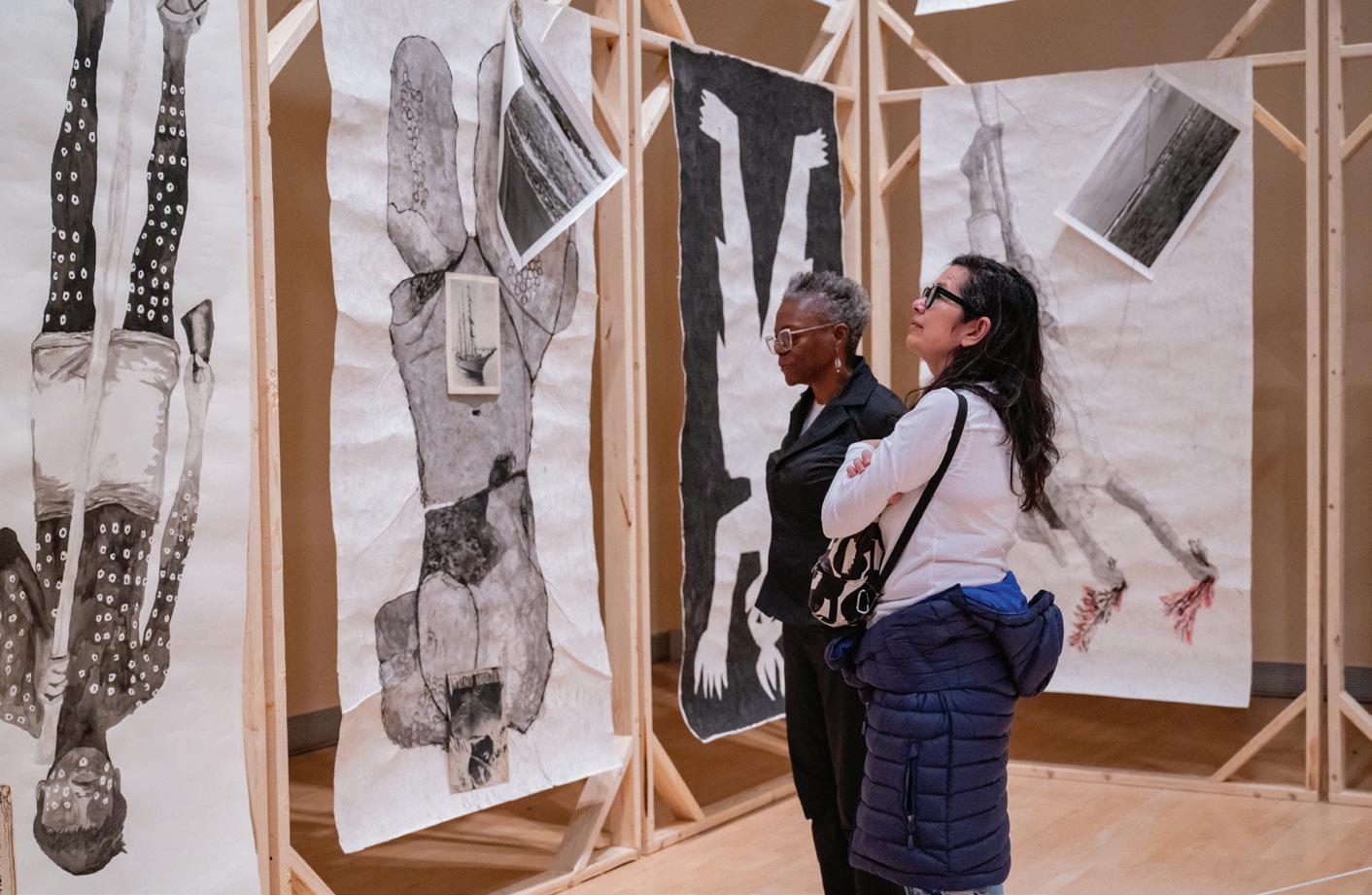
lated throughout these formative years.” Each painting is meant to capture a single moment and the accompanying emotional feeling it invokes.
Brianna Howards’ work is a series of prints and paintings that focus on texture and form. Howard utilizes a variety of materials such acrylic, caulk, insulation foam and spackling paste. The works’ unique physicality makes them very interesting to look at. “Ambrosia,” in particular, highlights these qualities. Made of caulk and acrylic on panel, the combination of the caulk’s thick texture with the pink and purple color scheme draws in the eye. Howard said that the goal of her pieces is to “intentionally explore a spectrum that oscillates between profound beauty and daring grotesqueness, that speaks to the complexity of my own experiences.”
Pavol Roskovensky also draws on his childhood as inspiration for his work, specifically his experience immigrating to the United States from Czechoslovakia as this severely impacted his identity. He specifically highlights his work “Two Triangles” using acrylic on canvas. “Two Triangles” consists of two partially deconstructed canvases placed side by side. The wispy threads of each canvas are conjoined together into a thick grey braid that rests between the two canvases. Peeking through the inside of the canvases are two bright yellow triangles. Of “Two Triangles” Roskovensky writes that “the unraveling threads symbolize both a rupture from the past and the challenge of building anew, while the raw canvas represents a boundless potential.”
The works discussed in this piece are only a small sample of all the art pieces featured in “Visceral Reflections,” the exhibit is open until Sunday, April 7 so be sure to stop by!
By GIANNA MORALES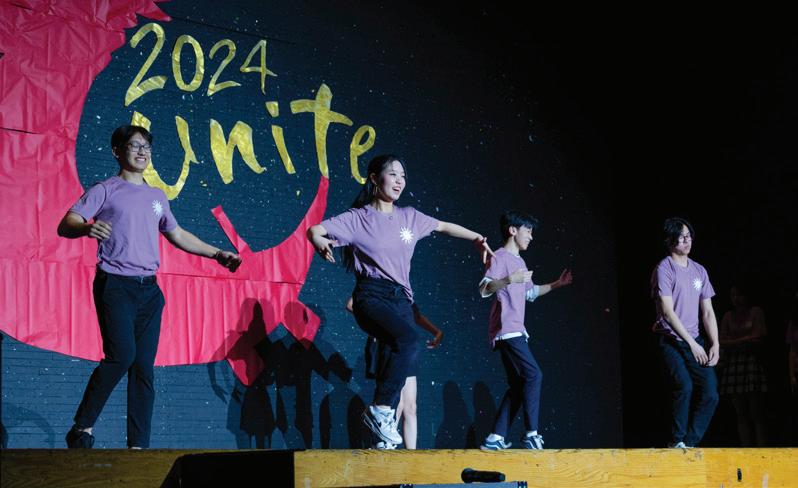
The Taiwanese Student Association presented their annual culture show; Formosa, on March 16 in Levine Ballroom. The immersive showcase captivated the audience with performances that demonstrated the meaning of unity through their theme: Dragon Boat Festival. The Dragon Boat Festival is a traditional Chinese holiday commemorating the ancient poet, Qu Yuan. The festival consists of dragon boat races and eating sticky rice dumplings called zongzi. Through this year’s theme, TSA encouraged the audience to embrace unity and to celebrate the meaning of togetherness.
TSA started their show off with a Diabolo performance that spotlighted multiple performers taking part in juggling two discs being spun around using a string attached to handsticks. Each performer wielded their diabolos with grace and precision while also interacting with one another to demonstrate the importance of being one.
As the show continued, a group of performers graced the stage with their presence and serenaded the audience with music. The entire room admired the performance and were in awe as all the singers worked together in harmonization and projection of their voices. The audience erupted in applause as the performance ended. The night continued with a martial arts performance and an e-board dance to finish it off. As the festivities came to an end, the night continued with food and celebration with members of the community.
As a whole, TSA put together a show that embodied the meaning of unity between Taiwanese students and the Brandeis community and how to carry that into other aspects of life. Through the performances, the audience was encouraged to create community outside of the space and to unite with one another to establish wholeness.

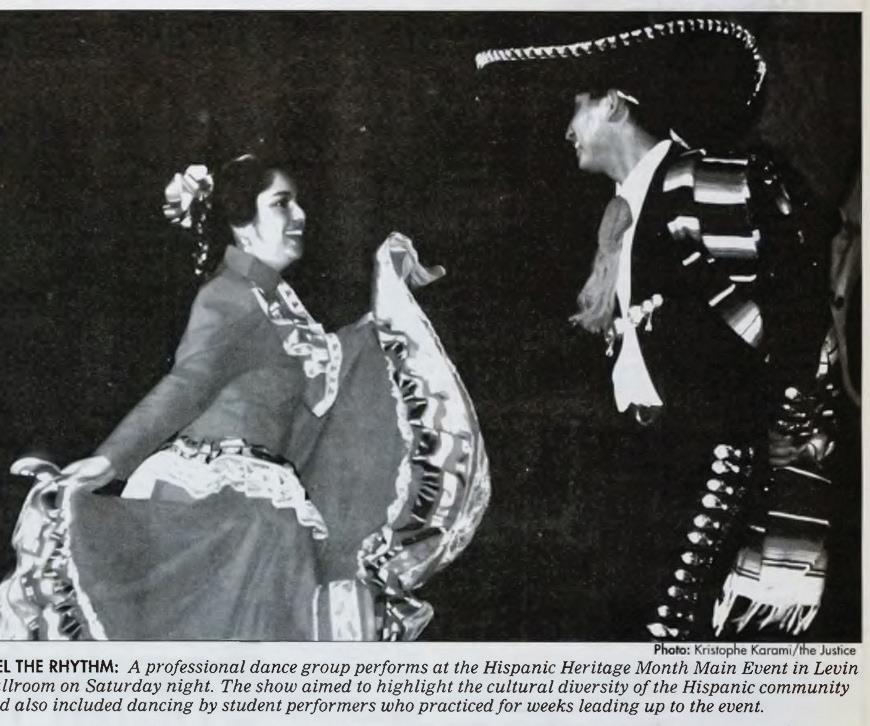

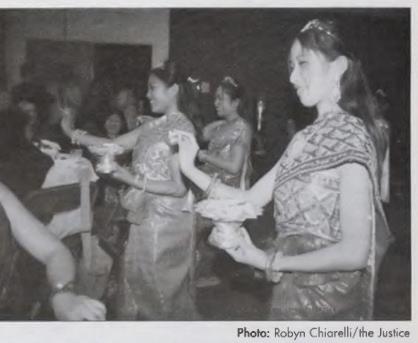

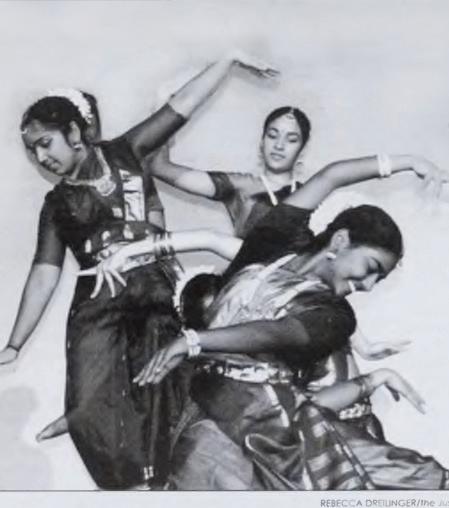
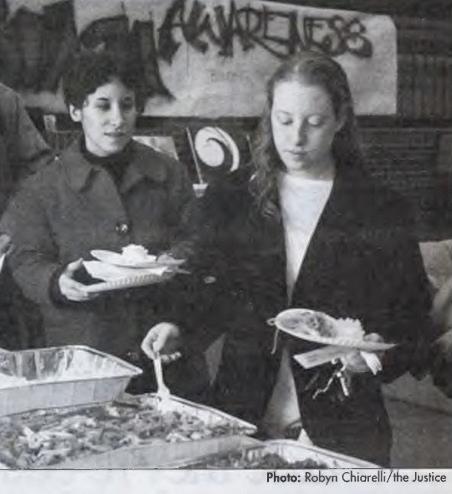

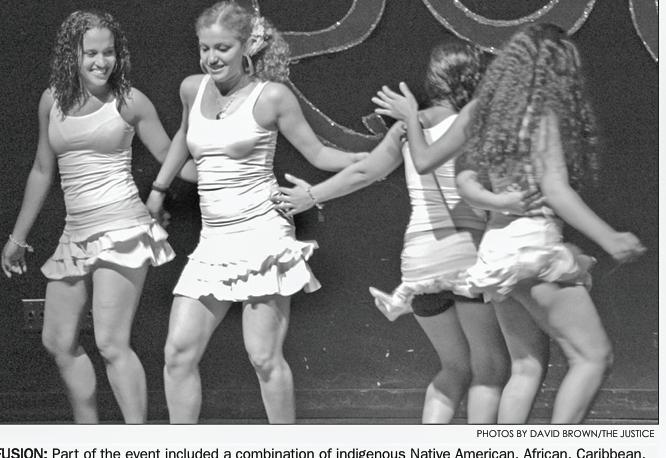
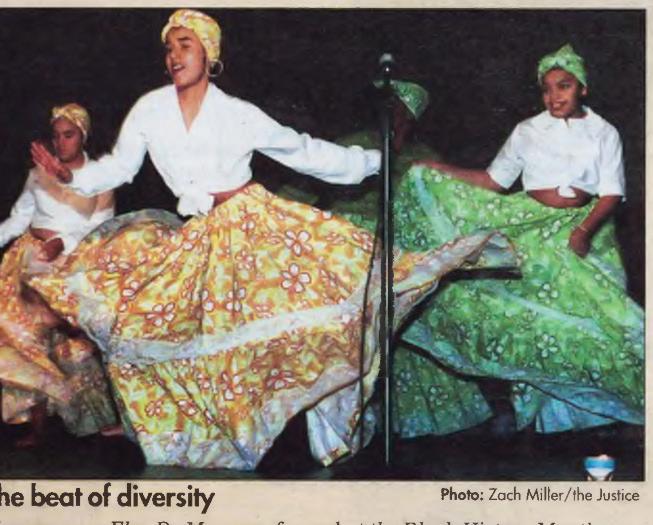
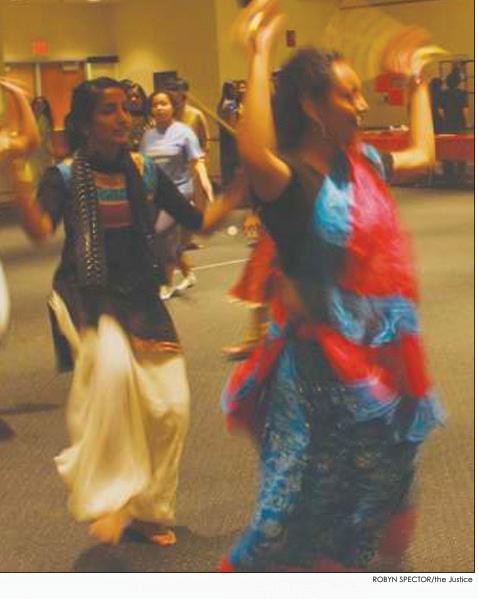

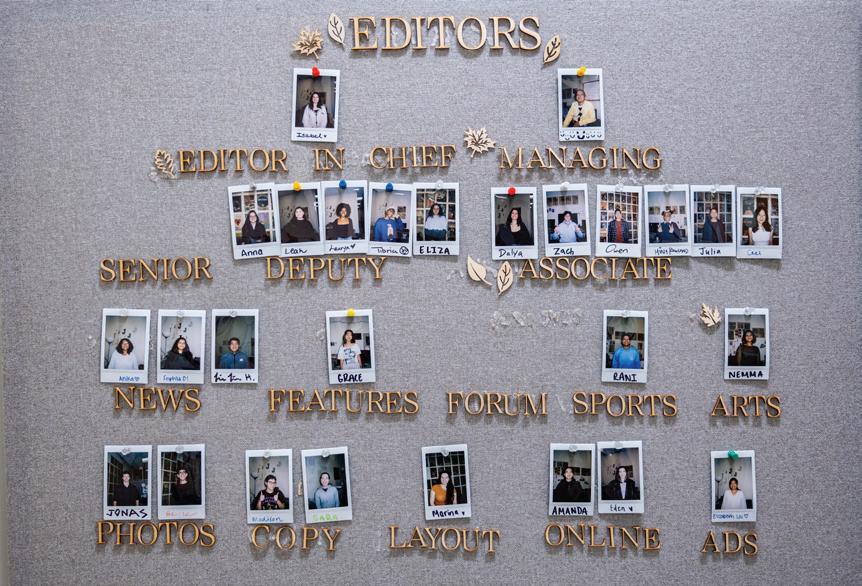
Thanks to production, every Justice editor is well acquainted with late nights. We all agree these snacks are of the utmost importance to our own survival and the production of The Justice Newspaper. Special thanks to Einsteins Bagels.
1. Sour Patch Kids
2. Einstein’s bagels
3. Ice cream
4. Einstein’s smoothies
5. Nerds Gummy Clusters
6. Einstein’s cookies
7. Cereal
8. Wheat Thins
9. Tortilla chips
10. Pickles
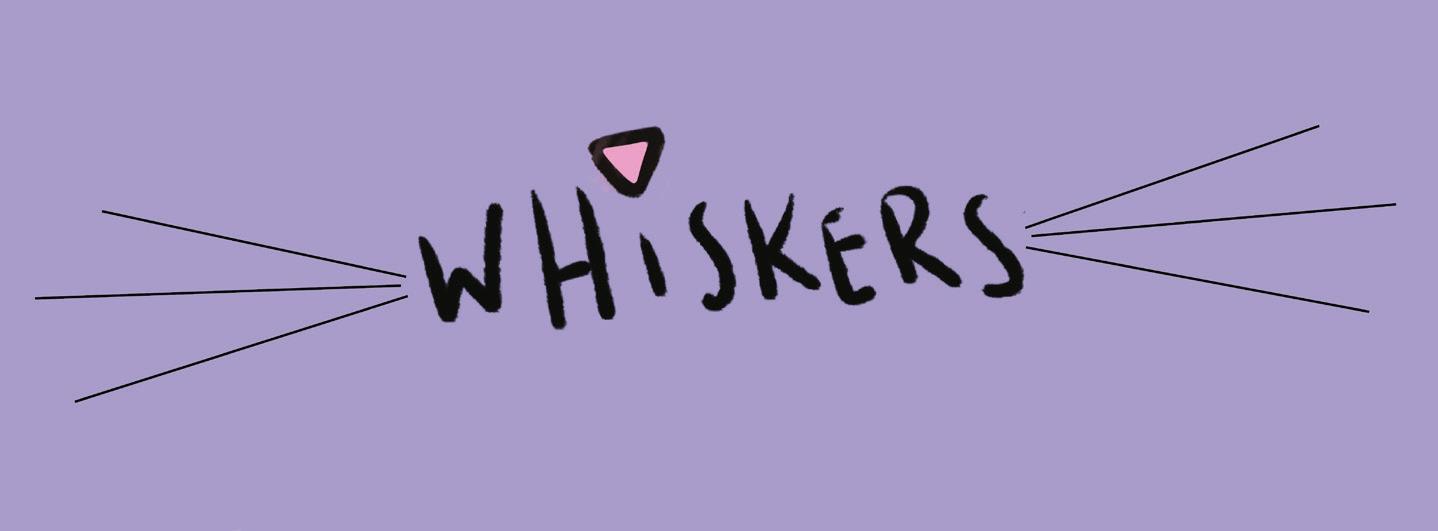 By DAHLIA RAMIREZ JUSTICE STAFF ARTIST
By DAHLIA RAMIREZ JUSTICE STAFF ARTIST

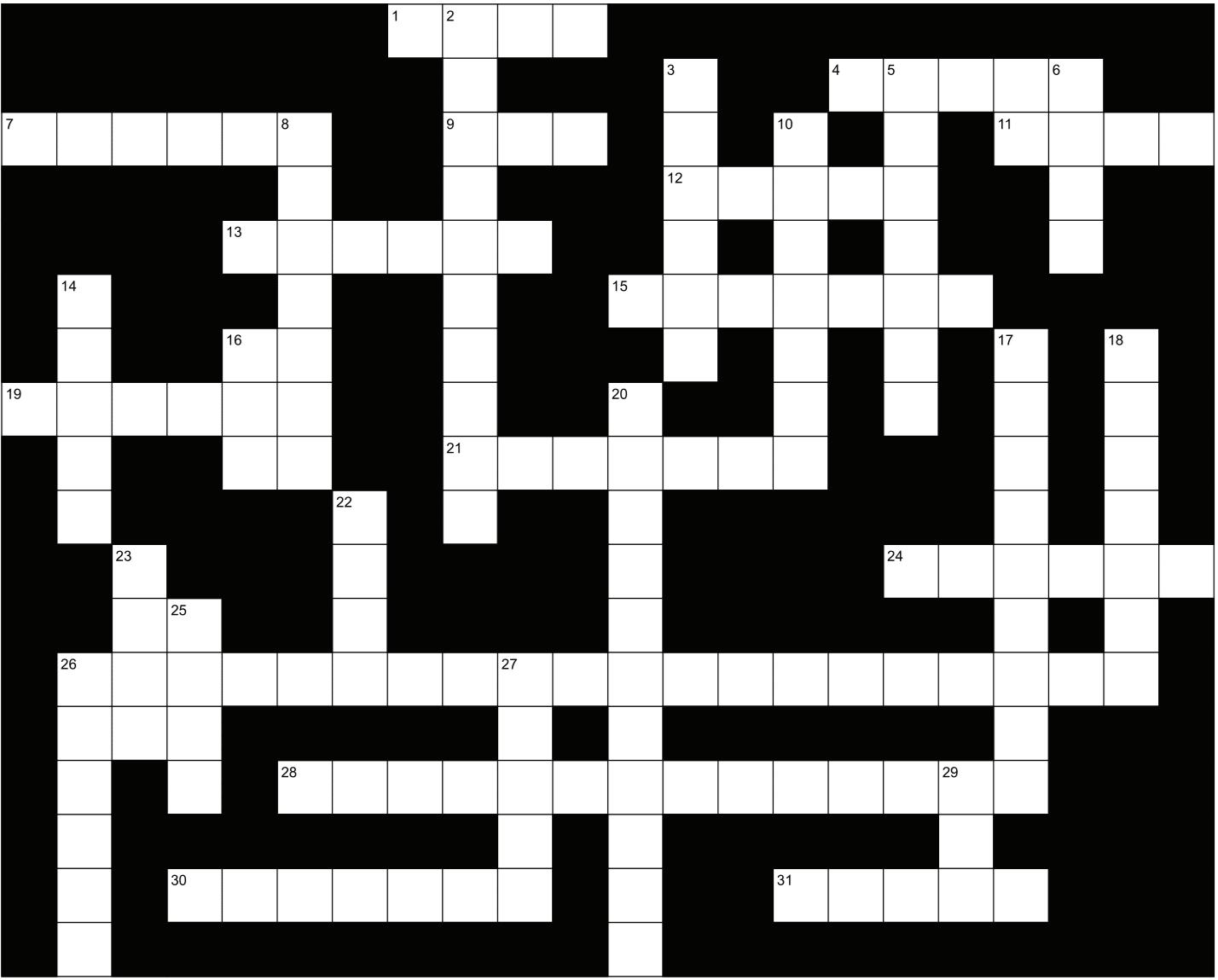
Down
2. annual University event related to a season
3. party, mixer, gala; in conjunction with [10 Down] makes a core value of the university
5. museum on campus
6. where lectures take place, in conjunction with [22
Down] are also protests held in 1969 and 2015 to promote racial justice and to improve the student experience at the University
8. most common name for buildings on campus
10. the name of the oldest newspaper on campus; in con
junction with [3 Across]
14. inventor of the q tip, location of the largest lecture hall on campus, colloquial
16. the University’s athletic conference, initialism
17. creative arts festival, named after former professor and famous composer and musician who was also the first American-born conductor to receive international acclaim
18. three buildings on campus thatnever cast shadows on each other, also a field
20. the original mascot of the University
22. american motor company named after their founder
Across
1. name of the castle, the only original building on campus
4. into its innermost parts
7. athletics-related nickname
9. our current, ninth, president
11. name of the toughest set of steps on campus
12. cafe on campus that fictitiously inspired F.R.I.E.N.D.S.
13. original building location of The Justice, also known as Waltham Hall; yellow fruit
15. city where University is located
19. couple buried in a woods named after them on campus, also the University’s first president
21. most recent building built on campus
24. a section in sherm; foods that conforms to the Jewish dietary regulations of kashrut
26. namesake of University, first Jewish Justice, full name
28. German-born theoretical physicist the University was almost named after but they refused, famous for the theory of relativity, E=mc2
30. professional team that used to practice on campus
31. the University’s student-run volunteer emergency service — also teaches CPR, acronym
View the solution at www.thejustice.org
who also made the five-day work week to grow the middle class and give them time to buy his cars 23. sound an owl makes, also the legal name of the C-store 25. University’s NARP nickname; [7 Across], ____, executioner
26. of reason, location for orientation tradition Light the Night
27. sculptor of the [26 Across] statue on campus commemorating the 100th anniversary of his birth; often adorned by students with a hat or other objects
29. culture hub on campus, initialism